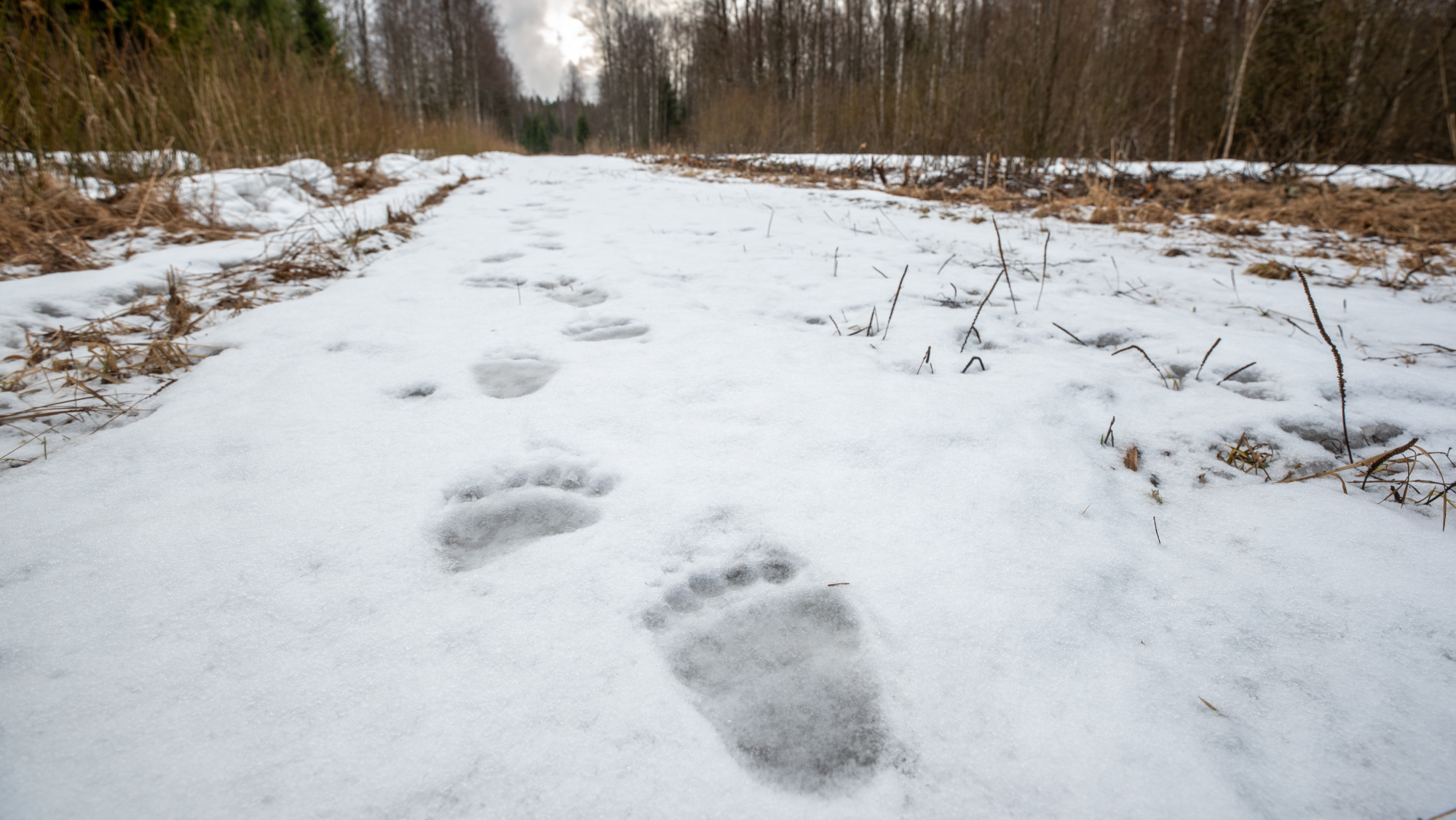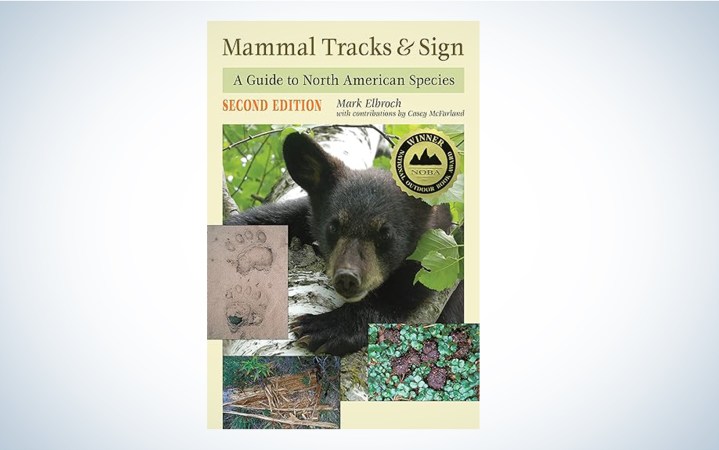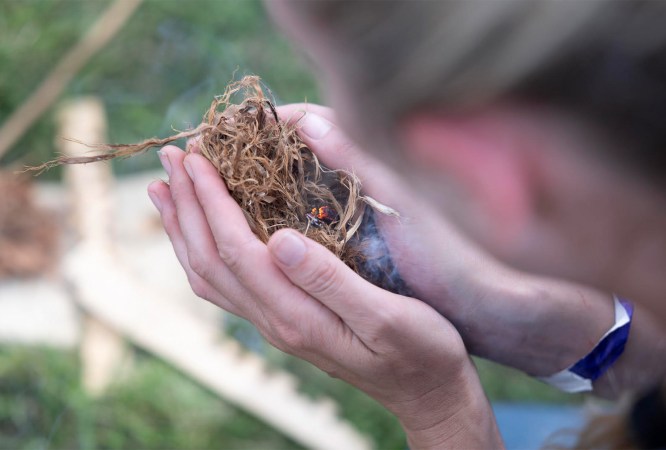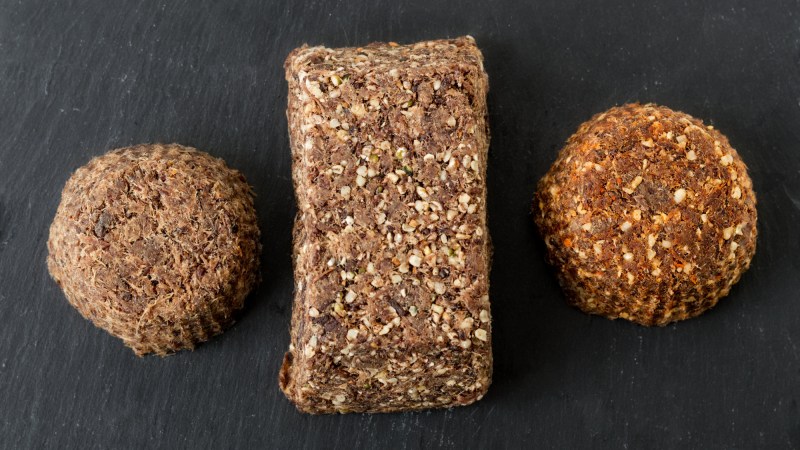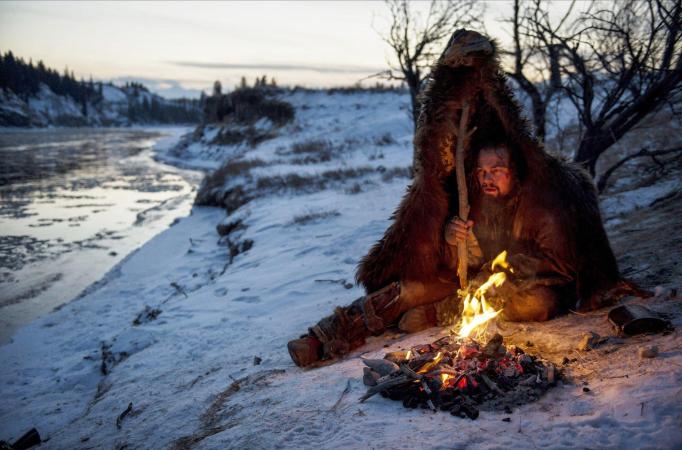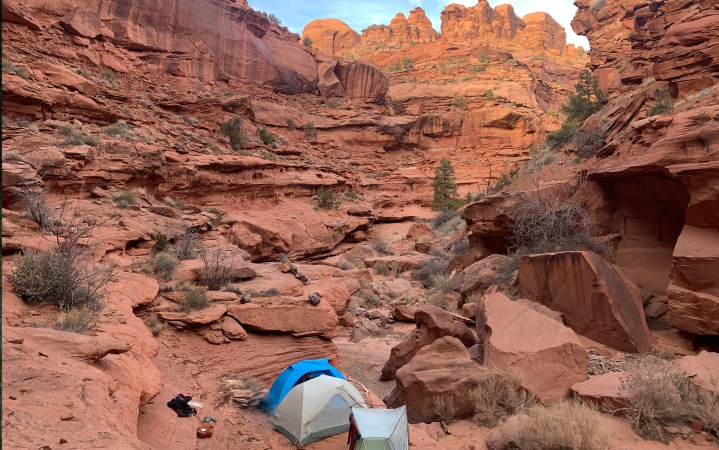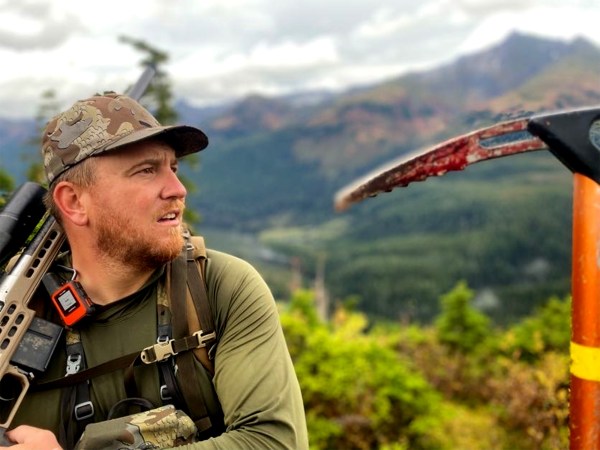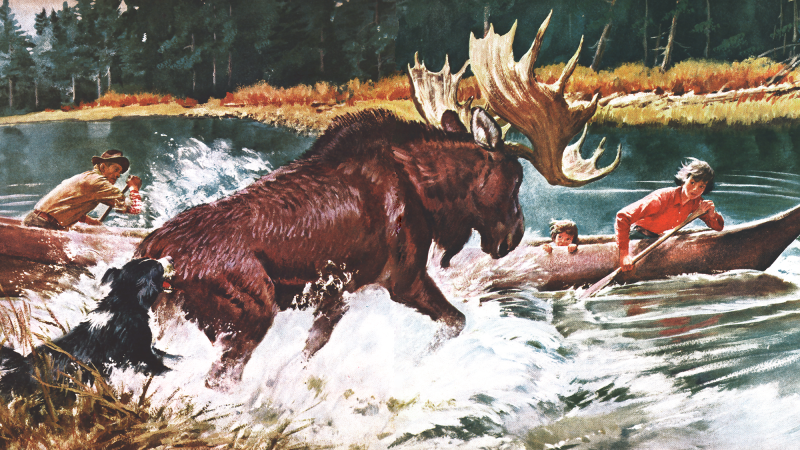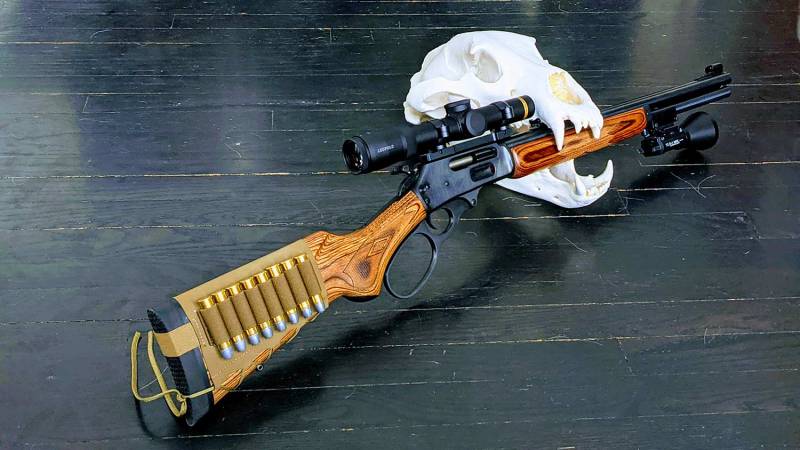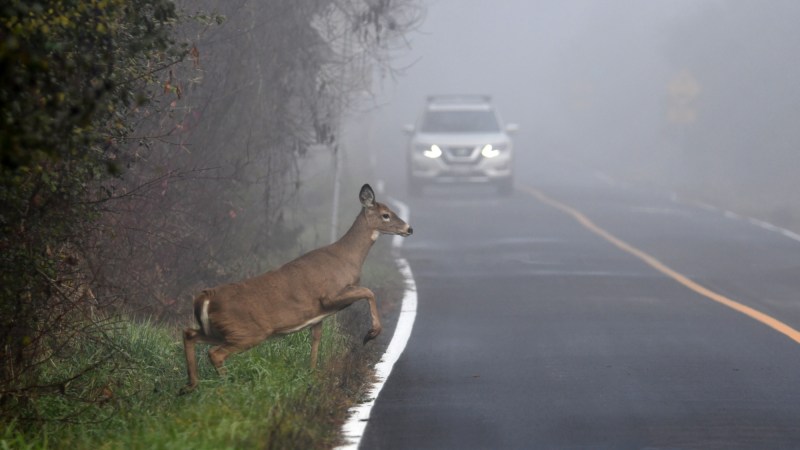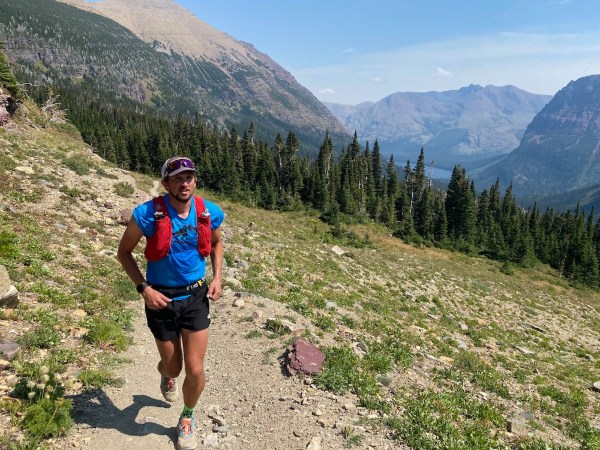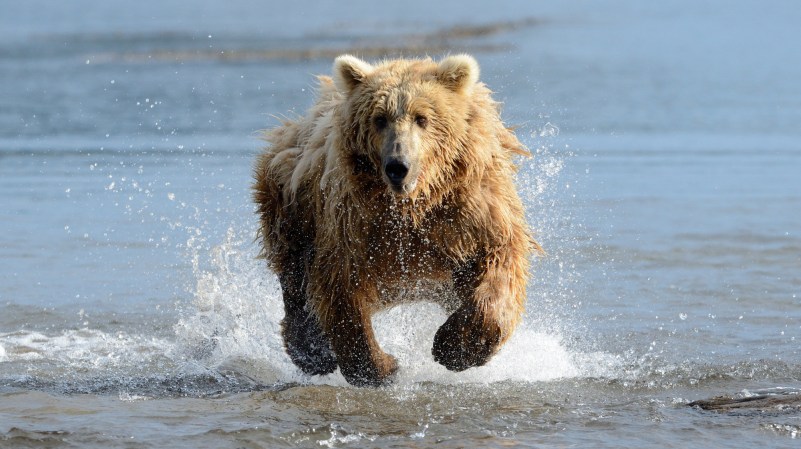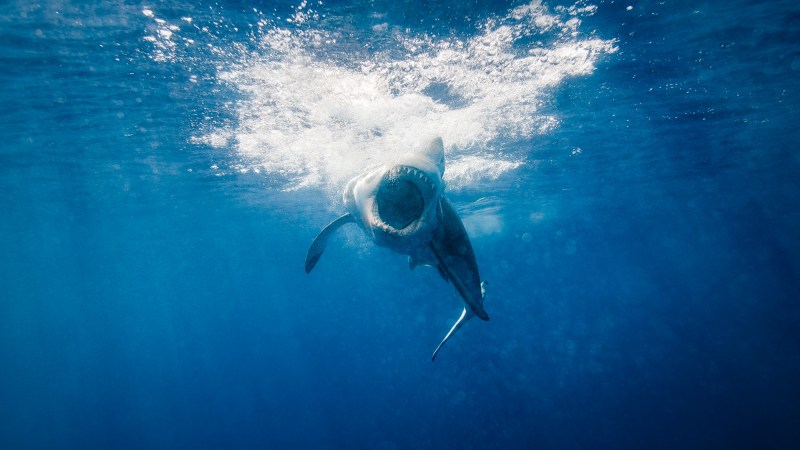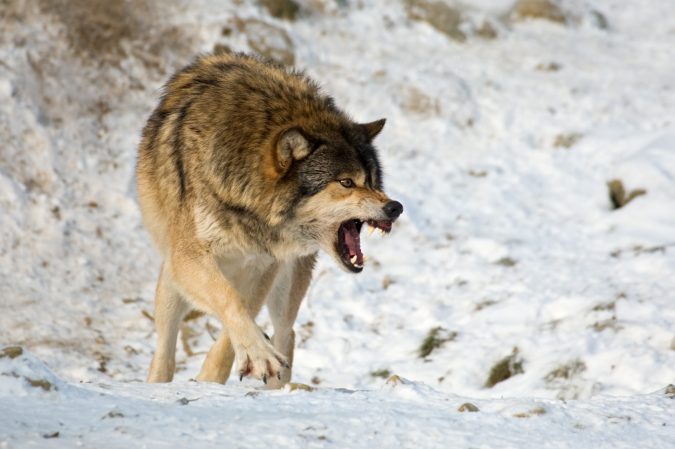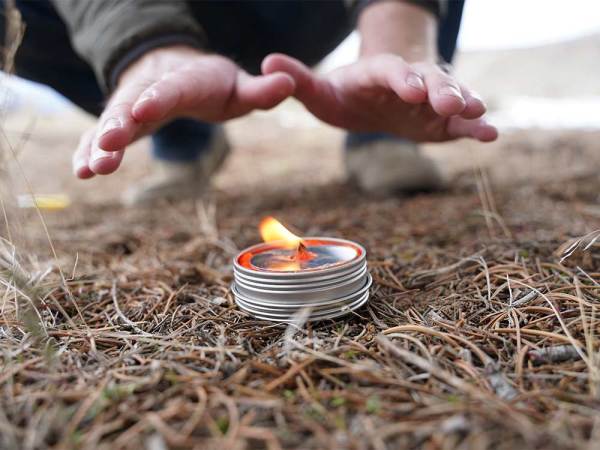Animal tracks are a key component to successfully watching, scouting, hunting, tracking, and photographing different wildlife species. If you want to know where the animals are, you often need to start by figuring out where they were, even if they aren’t there anymore. Sure, they may occasionally leave scat behind. (Brush up on your bear scat identification and deer scat identification just in case.) They might also scrape antlers, claws, or scent on nearby branches. But prints in the ground are the most reliable and ubiquitous bit of wildlife sign to look for.
While lessons in how to track deer and other game species benefit hunters, it’s also helpful to know how to track other species that we might not have tags for but would otherwise want to know the whereabouts of. If you see bear tracks on the ground, differentiating an old black bear track from a new grizzly track can be the difference between staying in a spot you should leave or turning around and avoiding a conflict.
Let’s dive into the wide world of animal tracks.
Animal Tracks: The Basics
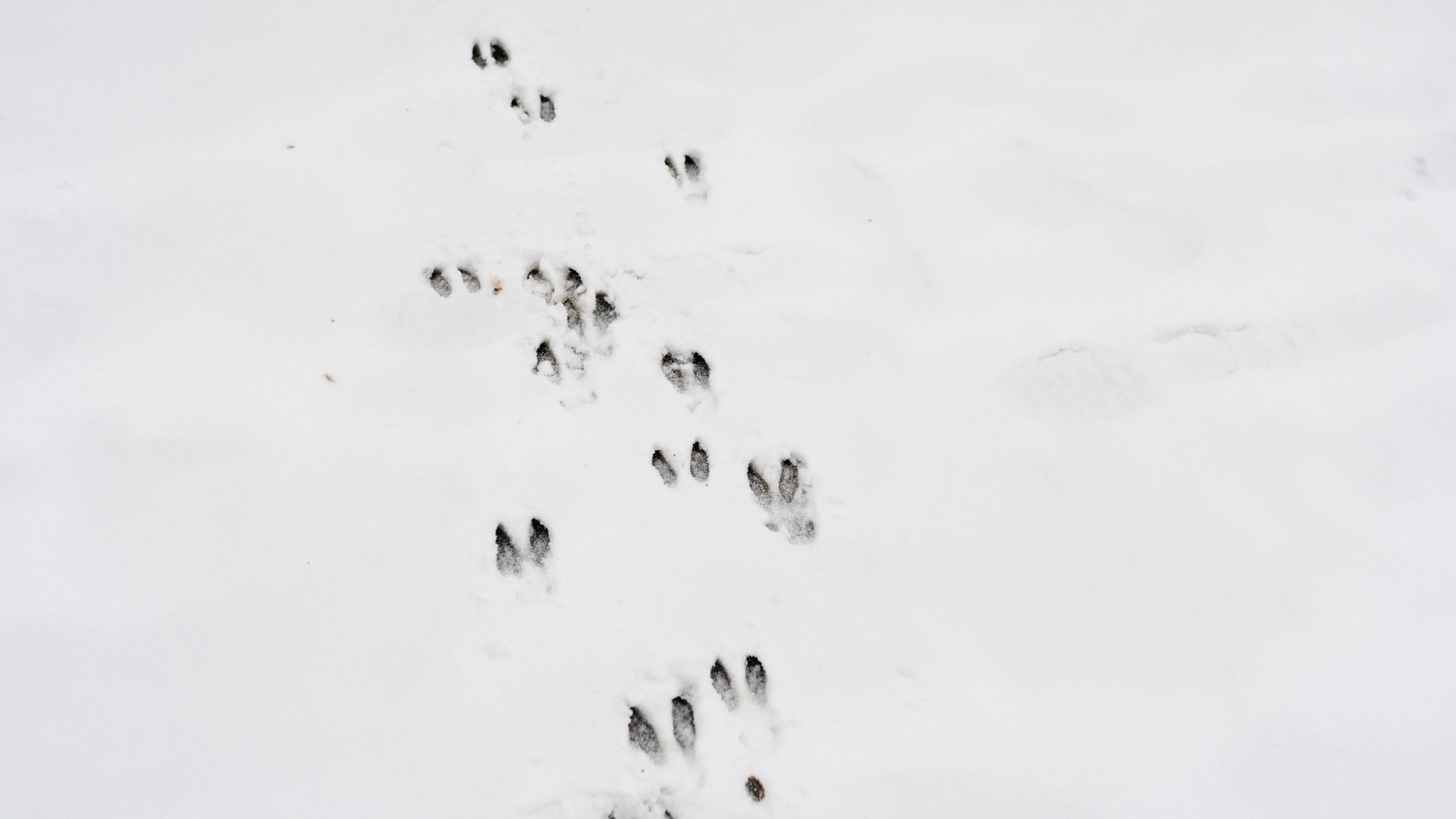
Photograph by Cheaspeake Bay Program
Every good animal tracker must first start by being able to recognize animal tracks on the ground, certified tracking expert Kim Cabrera tells Outdoor Life. That doesn’t necessarily mean you know what animal it belongs to, and maybe you can’t discern a track anywhere other than fresh mud or wet sand. But if you can at least recognize the presence of an animal track and understand that it can tell you something, you’re off to a good start. Every other piece of tracking knowledge comes with repetition.
“It’s all a matter of practice, of looking at lots of tracks over time,” Cabrera says. “That’s pretty much how you learn. We call it ‘dirt time.’ You’re spending your dirt time looking at tracks.”
Cabrera suggests starting out by finding an animal track and trying to follow it for 20 consecutive steps. Local parks, sandy beaches, areas with fresh snow, or even light-colored cement sidewalks could work if you happen upon wet pawprints. This could be easy or hard depending on where you are. You could probably follow a domestic dog on a beach for twice as long, if not longer. But how long can you follow a deer track through dense woods in light snow on a windy day?
When the clear impressions in mud turn into messy grass or leaf litter, look for a pattern of depressions in the ground — even if they don’t look like obvious cloven hooves or pawprints. See if you can spot crushed or even bruised vegetation, mud spattered on otherwise clean leaves, or broken sticks, Cabrera says. Remember: Some critter made that mark. It’s your job to figure out what kind, and why.
Additional information about your location is also necessary for identifying animal tracks. For example, knowing which bear species do and do not exist in your area can save you a lot of time in trying to figure out if you’re looking at a black bear or grizzly bear track.
What Animal Tracks Can Tell You
The next step beyond being able to recognize a track on the ground is analyzing the track for information. If you read a good example of an animal track properly, you can learn:
- What animal made the track
- What size the animal was
- What direction the animal headed in
- How long ago the animal made the track
- What pace the animal was moving at
- Whether the animal was alone or accompanied by others
Look for how crisp the edges of the track are. Has moisture or debris accumulated in the depression? Did wind or rain soften the edges of the track? These characteristics can indicate how long the track has been exposed to the elements. Think about seeing your own footprints in sand or boot tracks in snow. If you go back to the same place a few days later, what do they look like? Certainly they’ve changed since you left them behind.
Aging Animal Tracks
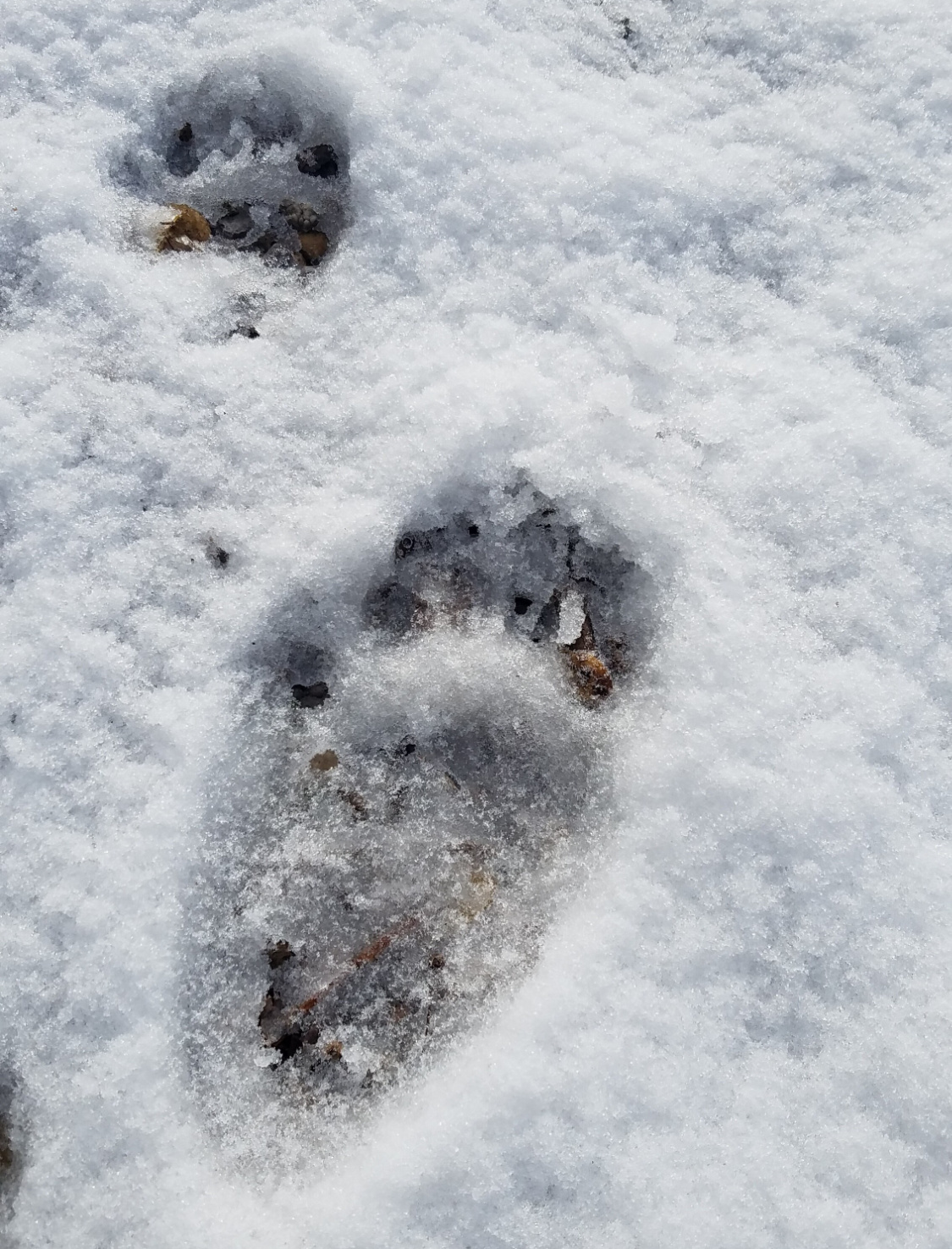
Photograph by Gila National Forest
Determining how old a print is can be difficult, but also extremely useful to trackers. As Cabrera points out, the age of the track will help a tracker figure out if the trail is worth following or not. If the prints are a few days old, the likelihood of seeing the animal that made them is pretty low. But if they’re fresh, they’re more worth following.
To figure out how old a track is, first assess the edges. Are they crisp and defined? Is the soil or sand moist or more dried out? What about the soil inside the track? Is it a lighter color than the soil beneath it, or is it still dark? Then, think back on the weather over the last few days.
“When was the last rain, or snow, or wind event?” Cabera asks. “Tracks accumulate debris as they age.”
If the edges are crisp, the exposed dirt is still somewhat dark, and the track doesn’t hold pine needles or leaf litter or other debris, keep chasing it — you might find the critter that left it behind. Otherwise, make note of where you found it and maybe check back in a few days for fresher tracks.
Best Surfaces for Tracking
The surfaces where animals walk, also known as “substrate” in the experienced animal tracking world, vary in terms of how well tracks show up on them. Keep this in mind when you’re first starting out. Don’t go to a dry, hard-packed dirt or gravel trail if you want to find animal tracks. Instead, find a place that’s notoriously muddy. If it’s wintertime, wait for some snow to accumulate on the ground and go out as soon as it stops falling. If you live near a beach, dune, or other sandy area, try looking there first. Mud, snow, and sand are great substrates to track in because they’re soft and forgiving, which means animal tracks will be more visible.
Animal Tracks: Big Game Animals
All of these species are ungulates with cloven hooves that make symmetrical, heart-shaped tracks. They can be difficult to tell apart, especially in places where deer and pronghorn or moose and elk habitat overlap. Size and general habitat can help you distinguish them. Small cloven hooves on grassy flats in the prairie are likely pronghorn, while big hooves on a south-facing slope in the mountains are probably elk. Here are some of the most popular big game ungulate tracks of North America.
These sizes were pulled from a variety of reliable resources, like state game agencies and tracking websites hosted by Cabrera and Evans. The measurement ranges are helpful guidelines but aren’t completely set in stone. Fawns always have smaller hooves than mature adults, for example.
Deer Tracks
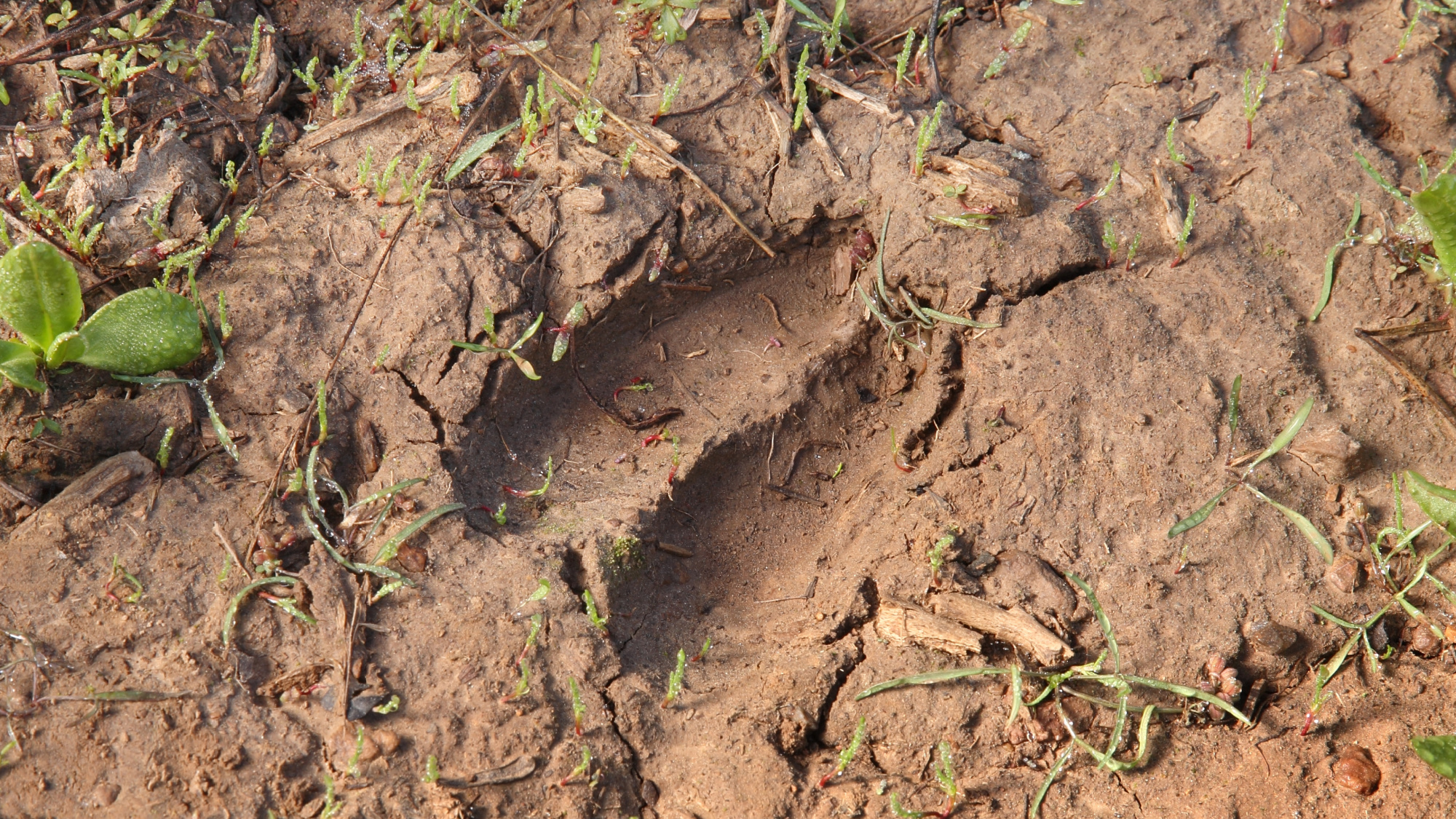
Photograph by Nathan Allred / Adobe Stock
Deer tracks are heart-shaped cloven hooves with pointy, inward-turning tips that sometimes feature dewclaws, depending how deep the substrate is where the deer stepped.
Deer track dimensions: 1 ⅜ to 4 inches long, ⅞ to 2 ⅞ inches wide
Elk Tracks
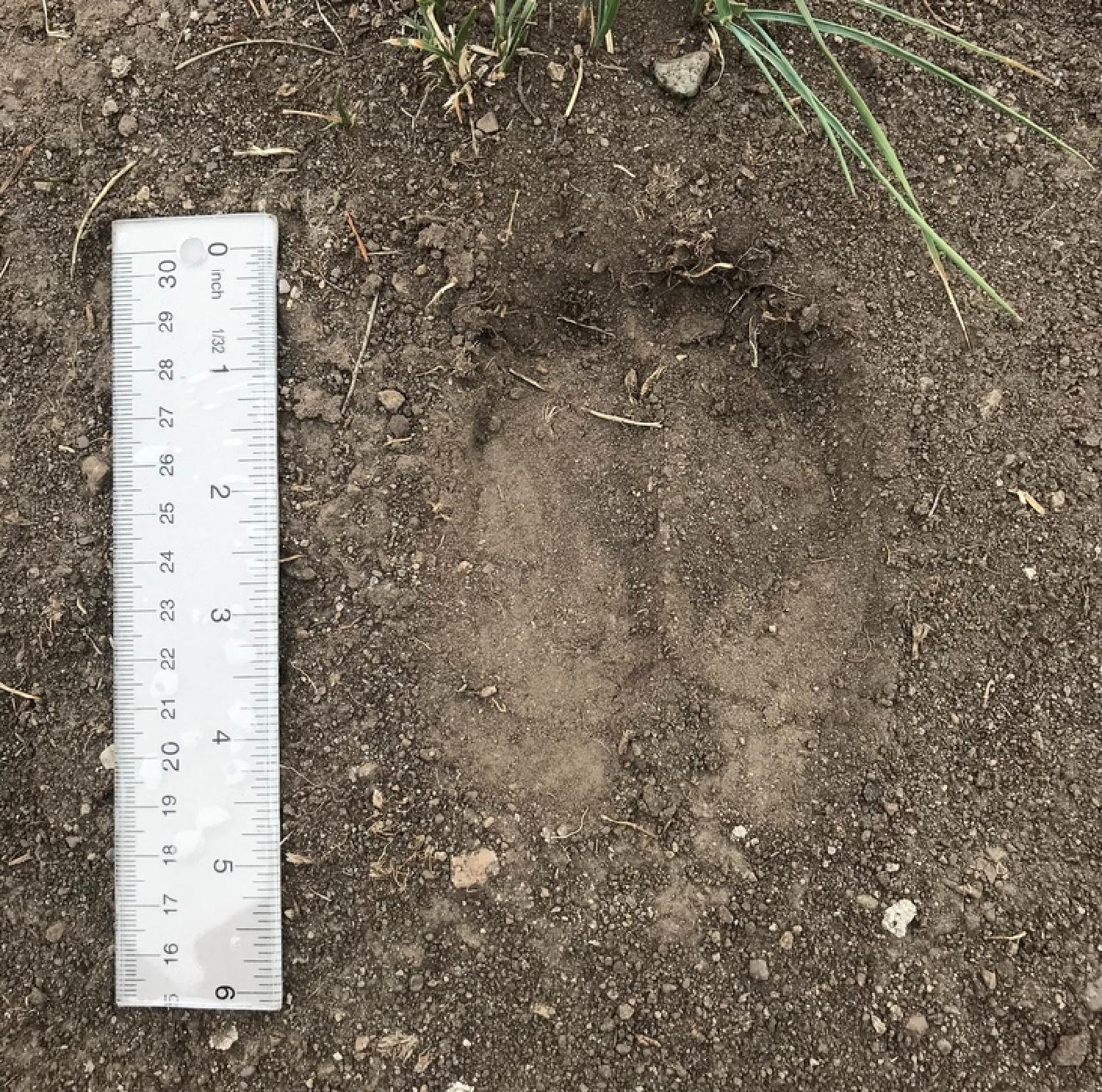
Photograph by Cody Stricker
Elk tracks are wider, bigger, and slightly more rounded than deer tracks. Their dewclaws are higher on their legs and are less likely to show up than a deer’s dewclaws.
Elk track dimensions: 3 to 5 inches long, 2 ½ to 4 ½ inches wide
Moose Tracks
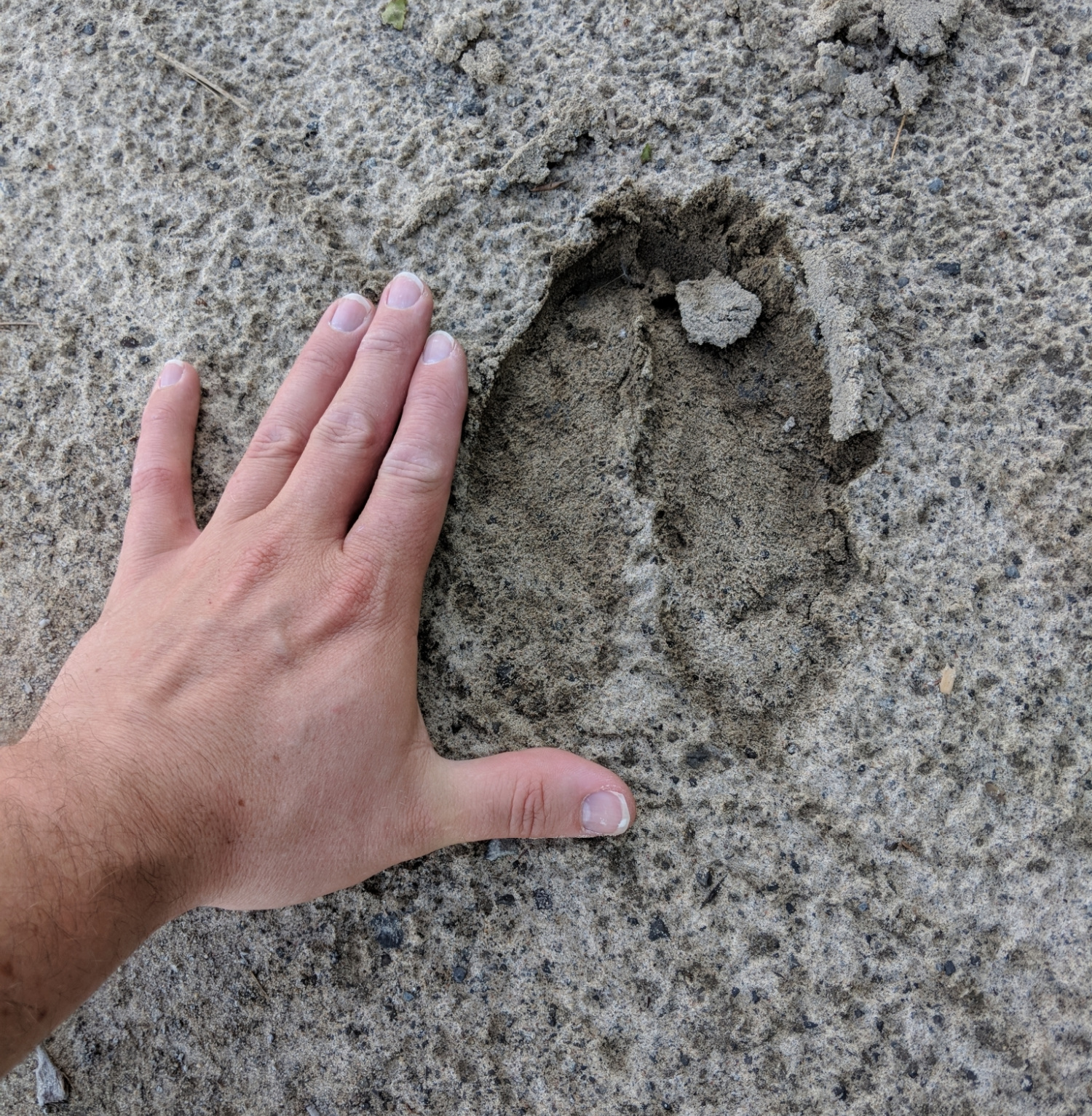
Photograph by Benoit Renaud
Moose tracks are more elongated and pointy than elk tracks. They look more like giant, heart-shaped deer tracks, whereas elk tracks are more round.
Moose track dimensions: 4 ½ to 7 inches long, 3 ¾ to 6 inches wide
Pronghorn Tracks
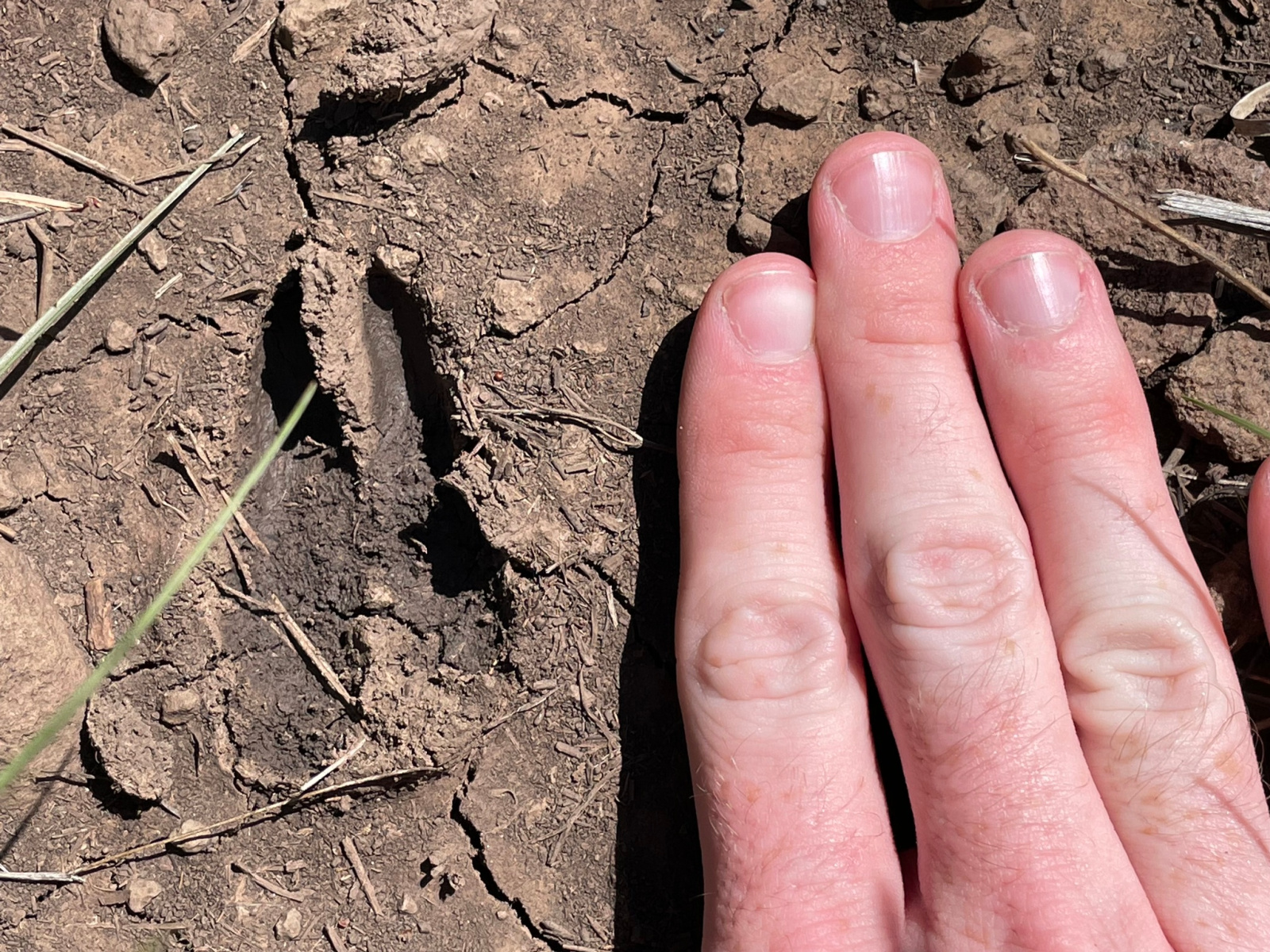
Photograph by Bobby McCabe
Pronghorn tracks are roughly the same size as deer tracks, but the outer edge of their tracks are usually straight or even curve slightly inward, rather than curving outward in the classic heart shape of a deer track. Pronghorn also lack dewclaws.
Pronghorn track dimensions: 2 ⅛ to 3 ½ inches long, 1 ½ to 2 ¼ inches wide
Bighorn Sheep Tracks
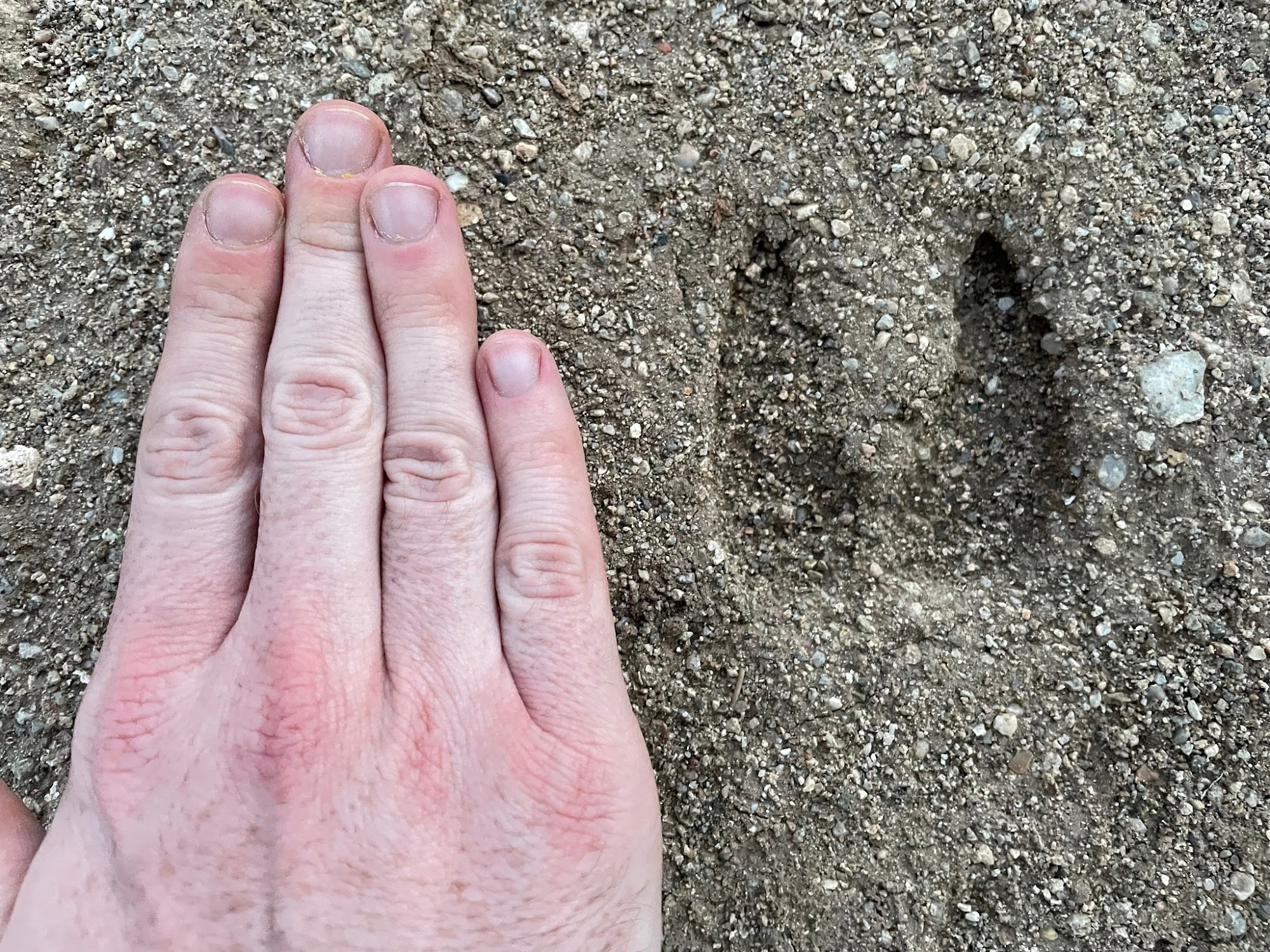
Photograph by Bobby McCabe
Bighorn sheep tracks, similar to pronghorn tracks, aren’t as curved on the outside and are more straight. They’re also blunter and less pointy at the tips.
Bighorn sheep track dimensions: 2 ⅛ to 3 ⅜ inches long, 1 ½ to 3 inches wide
Mountain Goat Tracks
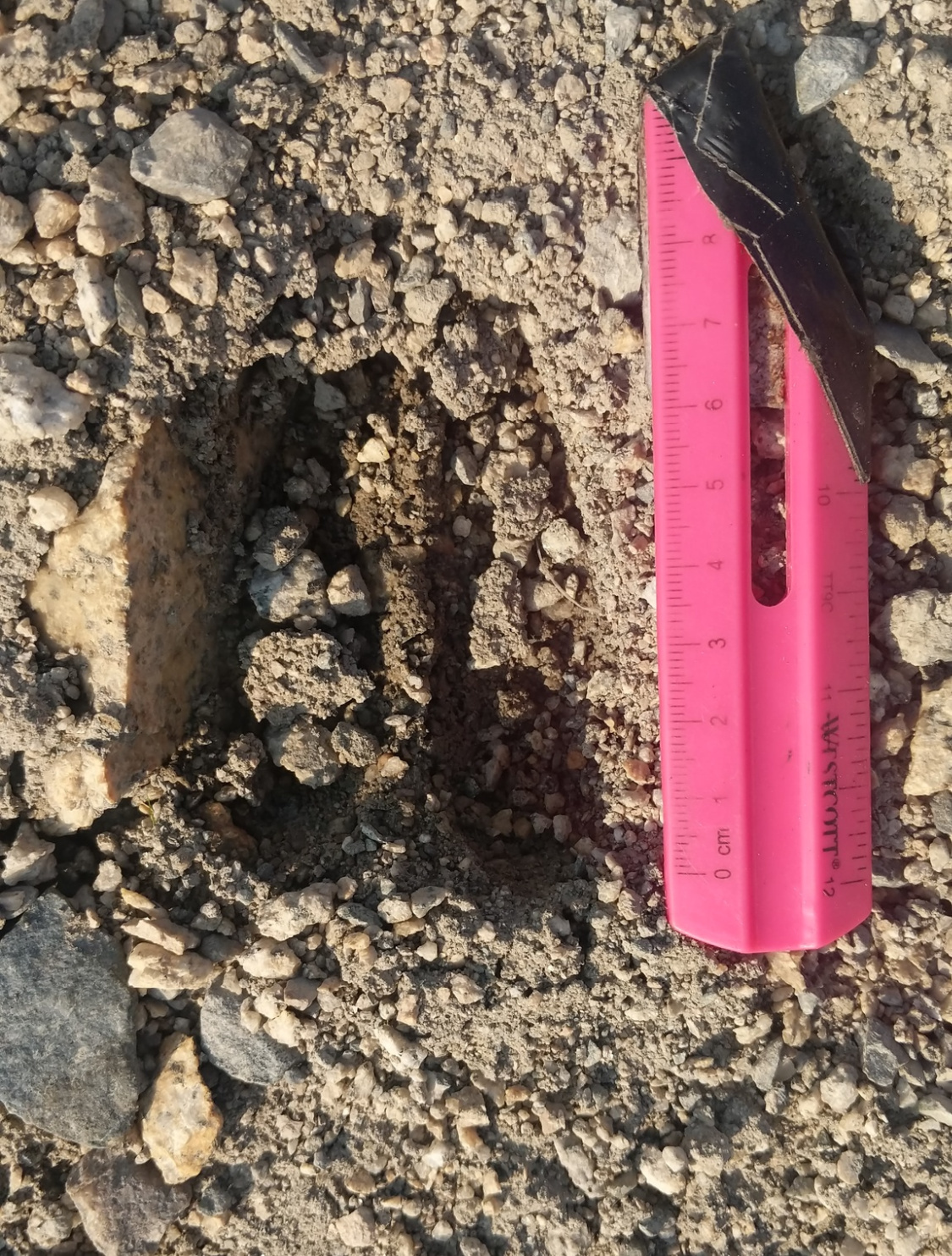
Photograph by Chloe and Trevor Van Loon
Mountain goat tracks are more rectangular than heart-shaped, with the hooves facing straight ahead in a similar fashion to bighorn sheep. The interior space between their hooves creates a “V” shape.
Mountain goat track dimensions: 3 to 4 inches long, 2 to 3 inches wide
Animal Tracks: Bears
Bear tracks are known for the major differences between their front and hind tracks. Their front tracks are more fragmented and some space might exist between their pads and heels, while their hind tracks create a single solid shape. Hind bear tracks also tend to be significantly bigger than front tracks.
Location matters when determining what kind of bear tracks you’re looking at. Grizzly bear range and polar bear range are both pretty limited to small pockets of the West and Alaska respectively, so if you’re in the Southeast and see a bear track, you can assume with near certainty that it belongs to a black bear.
Black Bear Tracks
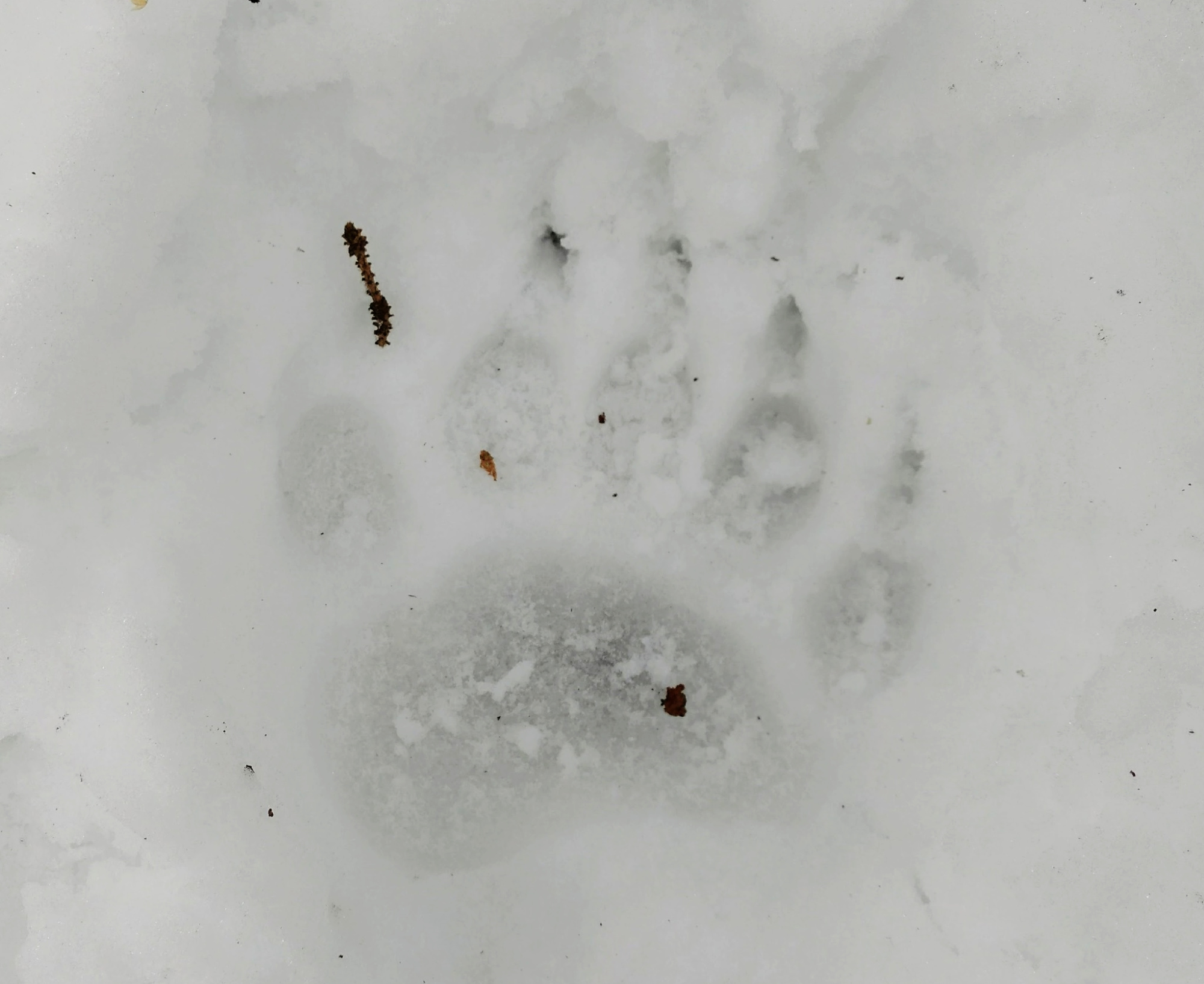
Photograph by Mark Apgar
The age-old way to tell a black bear track from a grizzly bear track is by imagining a horizontal line along the bottom of the five toes on a front track. If the outermost toe lands below that line, the track was likely made by a black bear.
Black bear track dimensions: 4 to 6 3/10 inches long, 3 ⅘ to 5 ½ inches wide (front tracks), 6 to 7 inches long, 3 ½ to 5 ½ inches wide (hind tracks)
Grizzly Bear Tracks
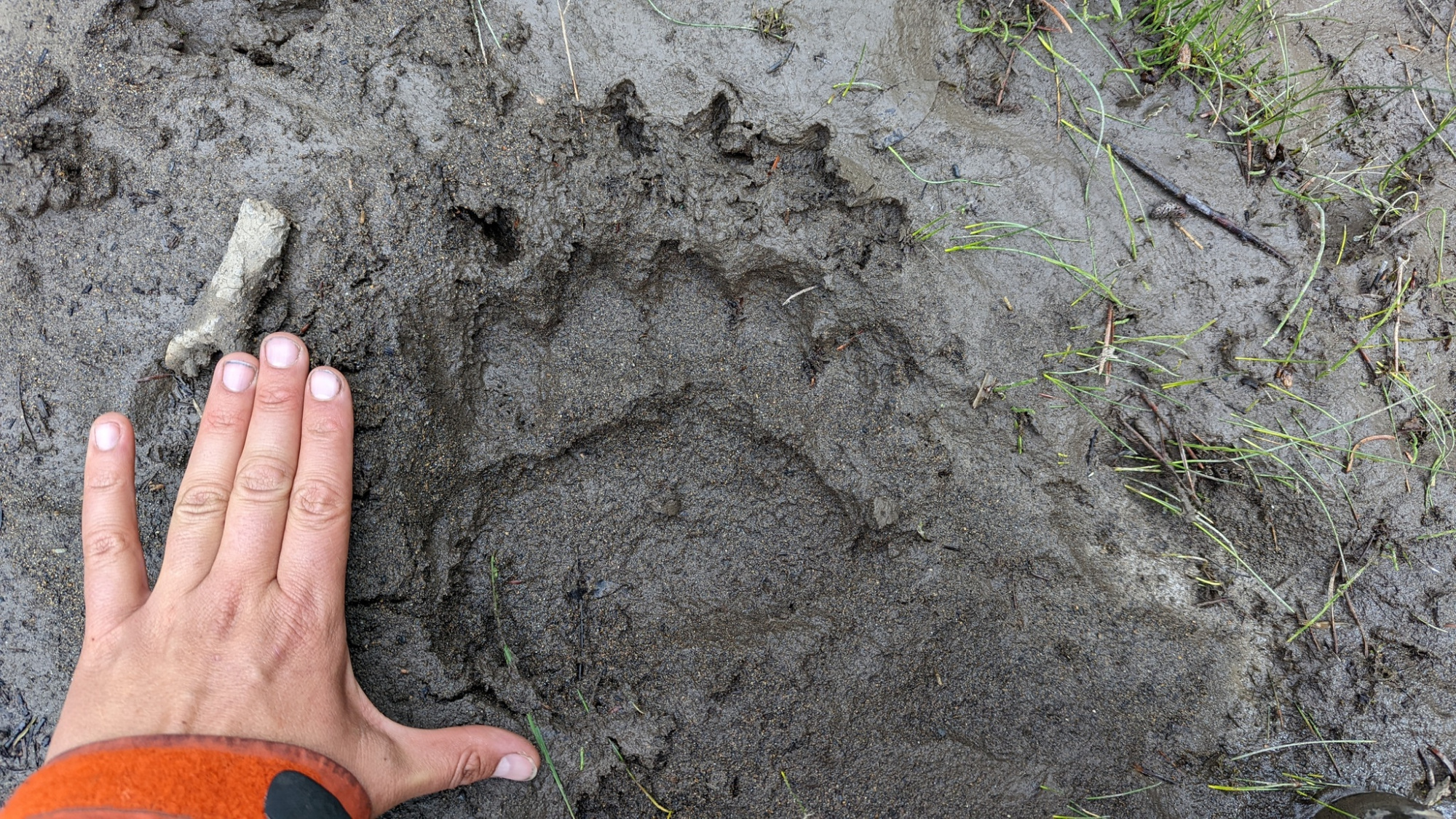
Photography by Chloe and Trevor van Loon
On the other hand, if you draw a horizontal line below a grizzly bear’s toes, they will all fall on top of that line rather than dipping below it. Grizzly bear tracks are also significantly bigger than black bear tracks.
Grizzly bear track dimensions: 7 inches long, 5 inches wide (front tracks), 11 inches long, 6 inches wide (hind tracks)
Polar Bear Tracks
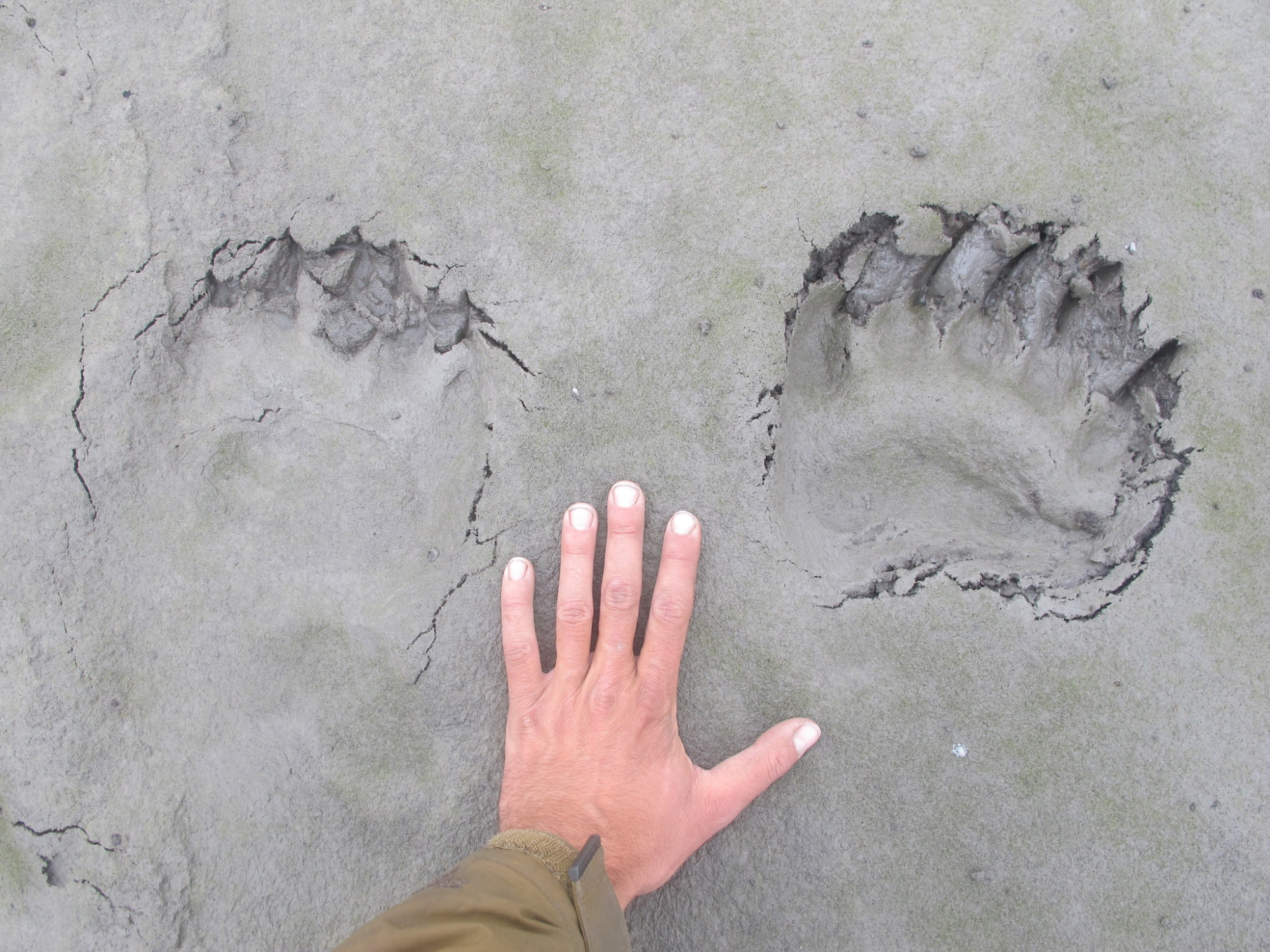
Photograph by the Bureau of Ocean Energy Management
The best way to tell if you’re looking at a polar bear track is to determine if you’re in polar bear range. Only small portions of northeastern Alaska and Canada are home to both grizzlies and polar bears, so if you’re studying a track in the mud in one of these areas, look to see if fur marks are visible. Polar bears have fur on the bottoms of their paws. Size is also a good indicator; polar bear tracks are absolutely massive.
Polar bear track dimensions: 5 ¾ inches long, 9 inches wide (front tracks), 13 inches long, 9 inches wide (hind tracks)
Animal Tracks: Furbearers and Small Game
These tracks all look more varied and unique than different species of ungulate or bear tracks do. Squirrel tracks and fox tracks, for example, look nothing alike. But one thing they all have in common is their relatively small size.
Squirrel Tracks
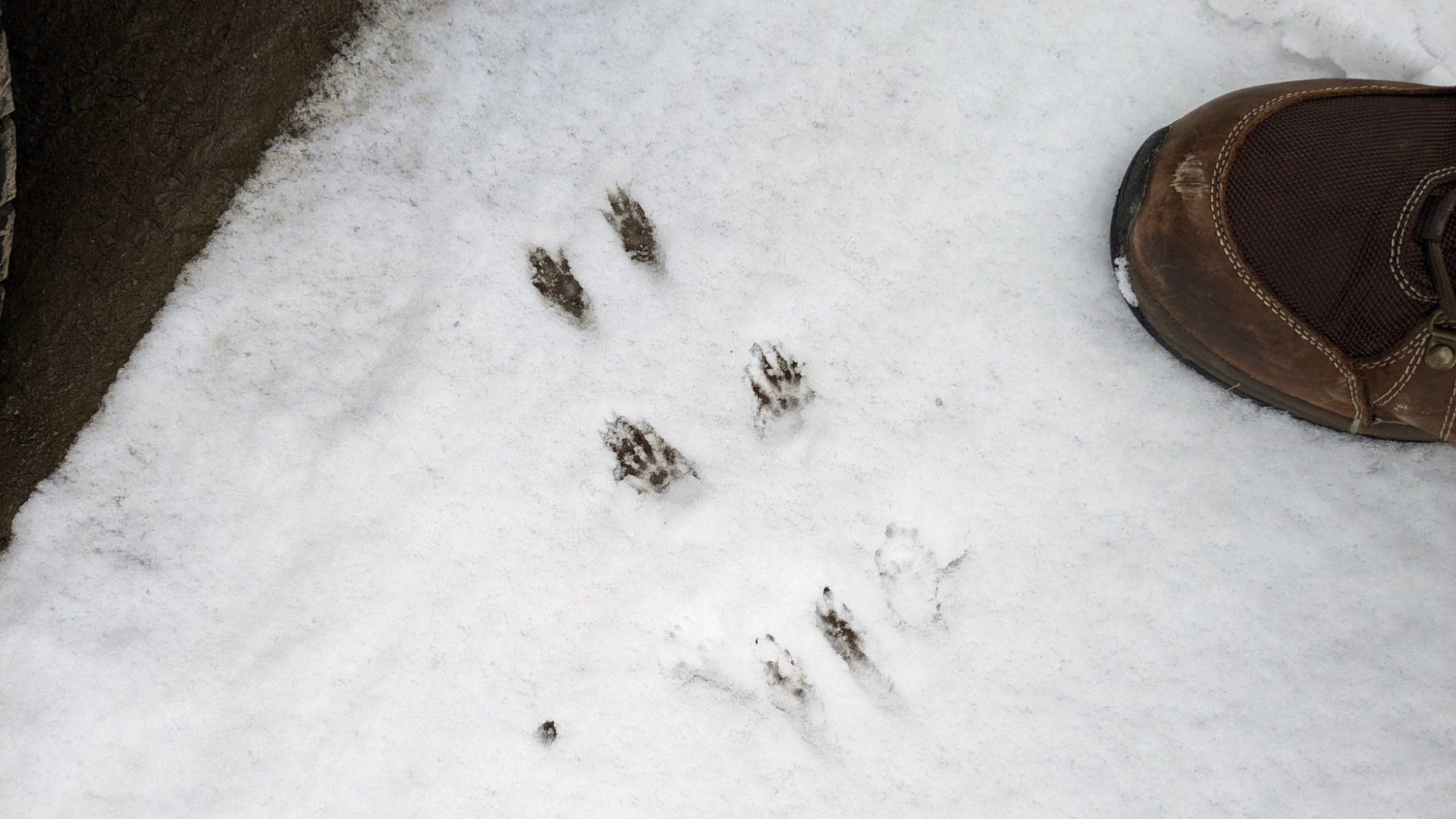
Photograph by Alicia Penney
Squirrel tracks are small and often seen in bounding groups of four, similar to rabbit tracks. They have five visible toes and small pads on their hind tracks and four visible toes on their front tracks. The front tracks are longer and more oval-shaped while their hind tracks are rounder.
Squirrel track dimensions: 1 ¼ to 1 ⅞ inches long, ¾ to 1 ¾ inches wide
Raccoon Tracks
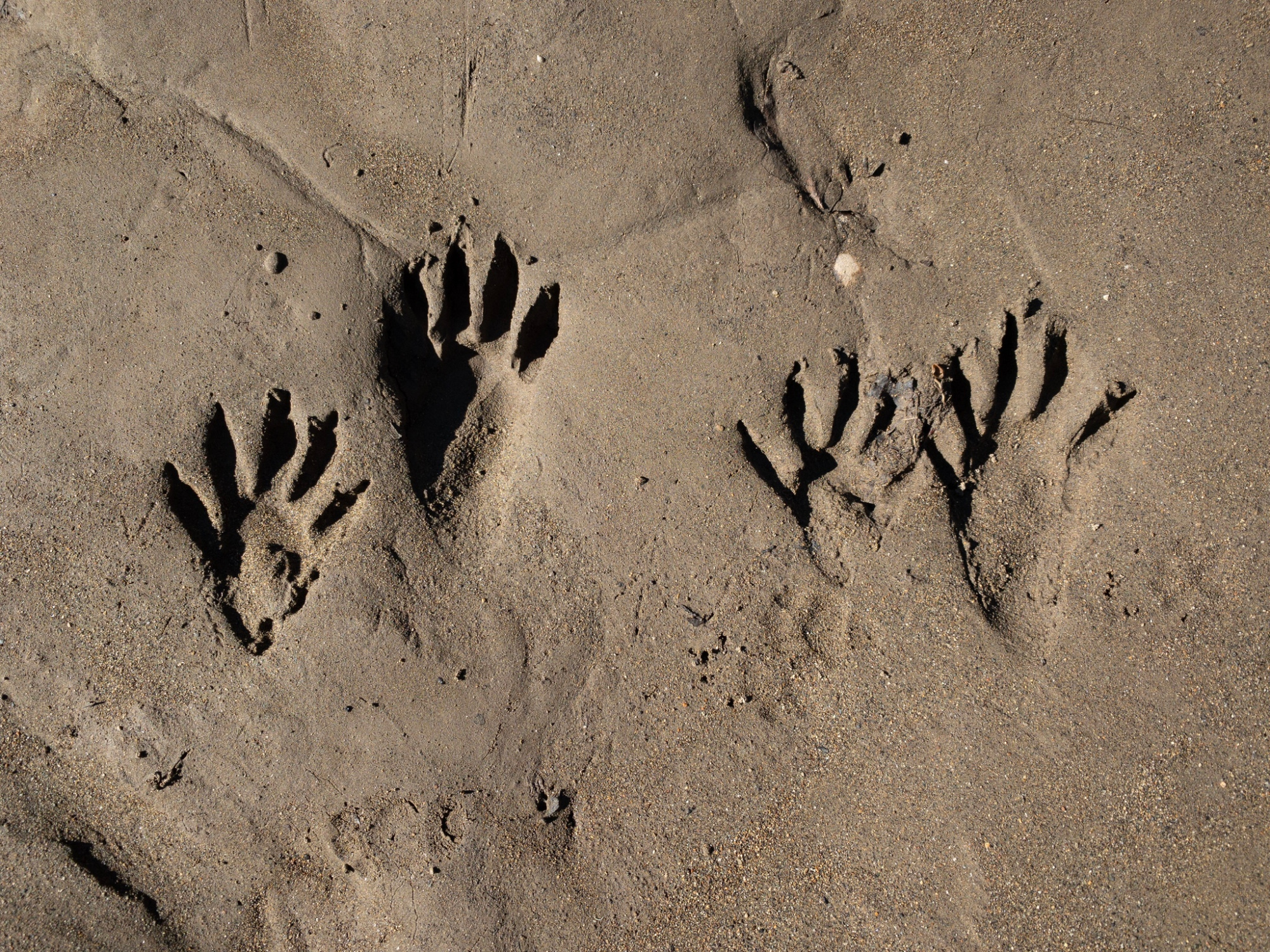
Photograph by Don Loarie
Raccoon tracks almost resemble tiny hands. Their front tracks have small pads, long fingers, and they might show tiny claws. Their hind tracks have larger, longer pads with five fingers and claws.
Raccoon track dimensions: 1 9/16 to 3 ⅛ inches long, 1 9/16 to 2 ⅞ inches wide (front tracks), 1 15/16 to 4 inches long, 1 7/16 to 2 15/16 inches wide (hind tracks)
Fox Tracks

Photograph by Mark Apgar
Fox tracks look similar to coyote tracks, except they’re smaller and all the fur around their toes makes the tracks less crisp and more fuzzy. They also have a unique callous on their hind pads that makes a tiny, horizontal ridge, almost in a chevron shape, Cabrera says.
Fox track dimensions: 1 ⅘ inches long, 1 ½ inches wide
Beaver Tracks
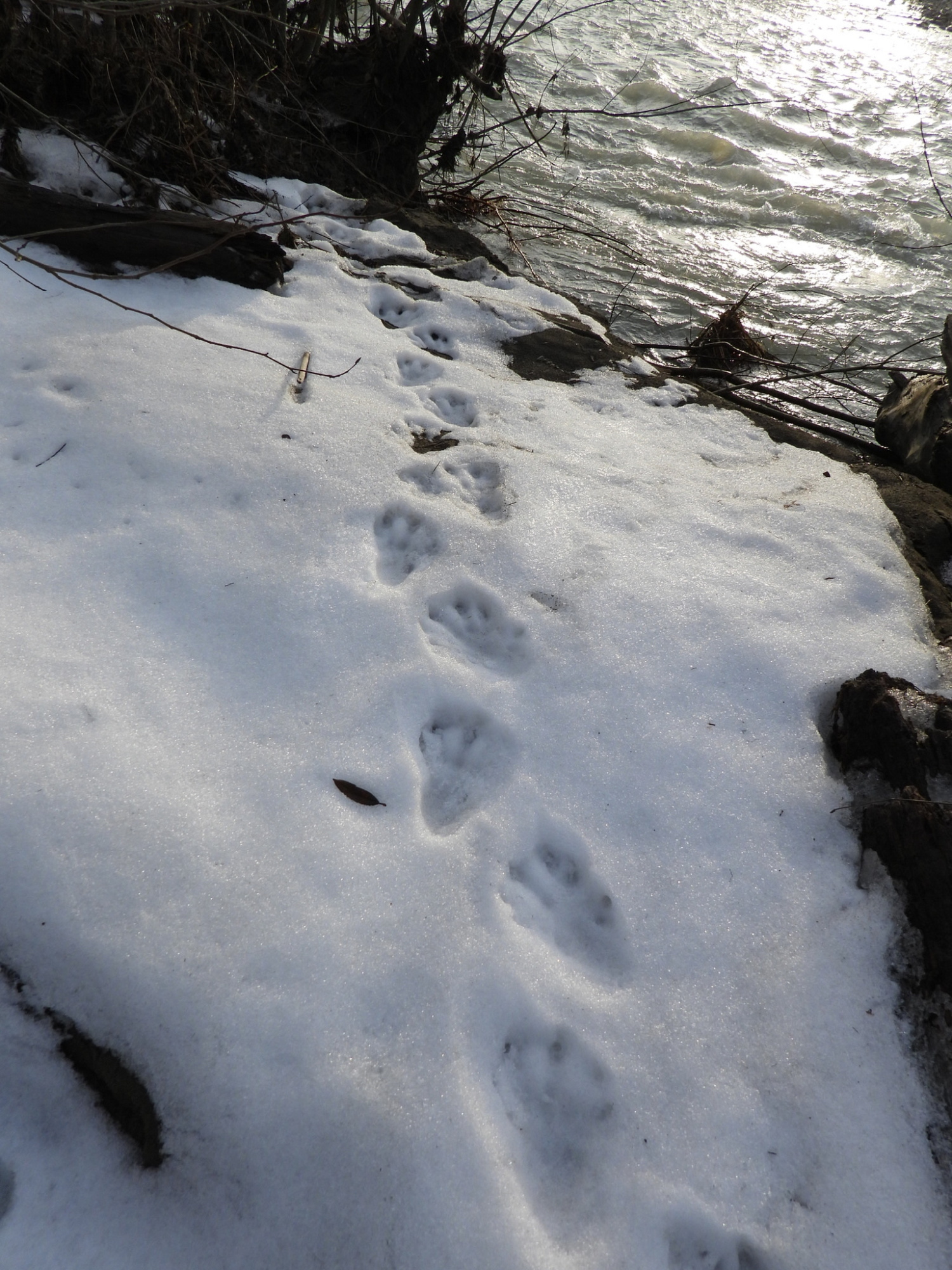
Photograph by Justin / iNaturalist
Beaver tracks are distinct for their large, webbed hind feet and their hand-shaped front feet with five fingers, similar to those of raccoons.
Beaver track dimensions: 2 ½ to 3 ¾ inches long, 2 ¼ to 3 ½ inches wide (front tracks), 4 ¾ to 7 inches long, 3 ¼ to 5 ¼ inches wide (hind tracks)
Animal Tracks: Predators
Most predators in North America, aside from bears, are split into either canines or felines. Telling a wolf track or a coyote track from a domestic dog track can be difficult, as can telling a house cat track from that of a mountain lion kitten.
The primary difference between canine and feline tracks are the heel pads. Felines have distinct three-lobed heel pads that create an M shape, while canine tracks have two-lobed heel pads. Canine tracks are more elongated while feline tracks are wider. Lastly, if big claws are visible, it’s likely a canine, since felines have retractable claws that rarely show up unless they’re pouncing on prey or running.
Wolf Tracks

Photograph by Erin McKittrick
Adult wolf tracks are large, elongated canine tracks that outsize almost any domestic dog track. Look for little space between toe pads and worn claw marks.
Wolf track dimensions: 3 ½ to 4 ½ inches long, 3 to 4 ½ inches wide
Coyote Tracks
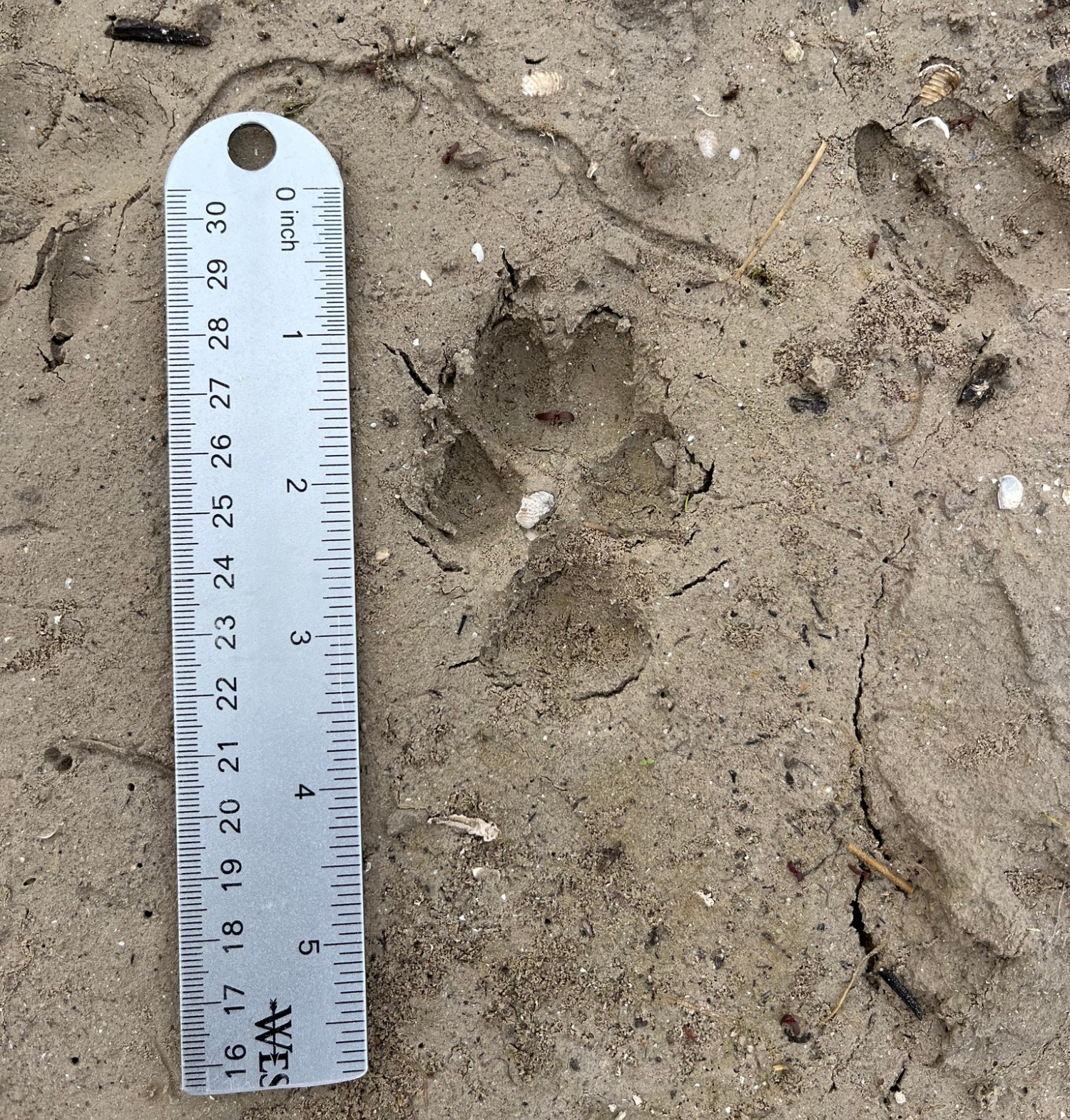
Photograph by Cody Stricker
Coyote tracks are a smaller version of wolf tracks. They have the same narrow width and worn claws.
Coyote track dimensions: 2 ¼ to 2 ¾ inches long, 1 ¾ to 2 ⅜ inches wide
Domestic Dog Tracks
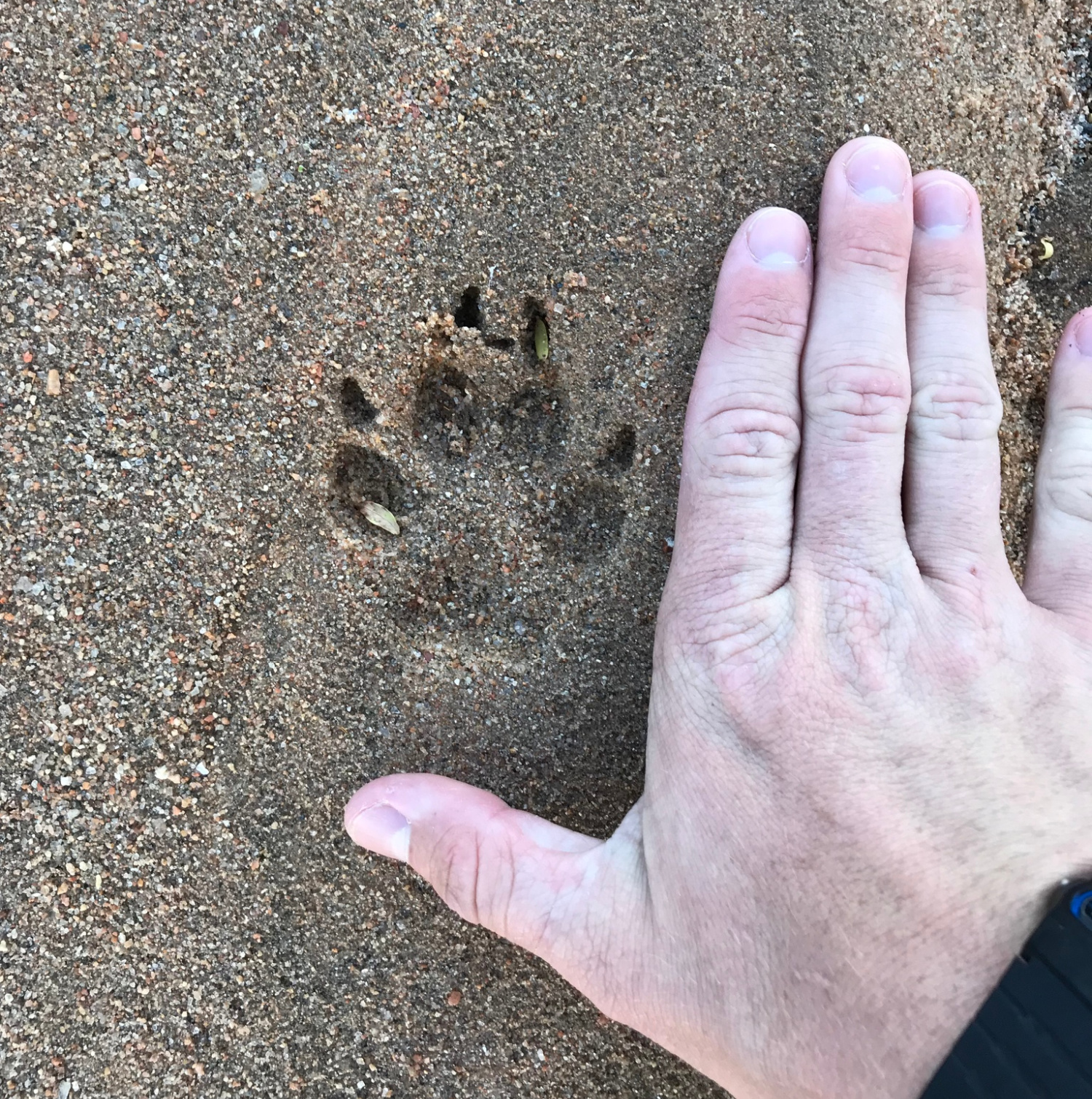
Photograph by Cody Stricker
Domestic dog tracks vary depending on the species in mind. But most domestic dog tracks are smaller than wolf tracks. They might have more defined claws from long periods spent indoors, and the overall shape of the track is usually a little wider and not as elongated as a wolf or coyote track.
Domestic dog track dimensions: Variable size by species, but less than 3 ½ inches long
Bobcat Tracks
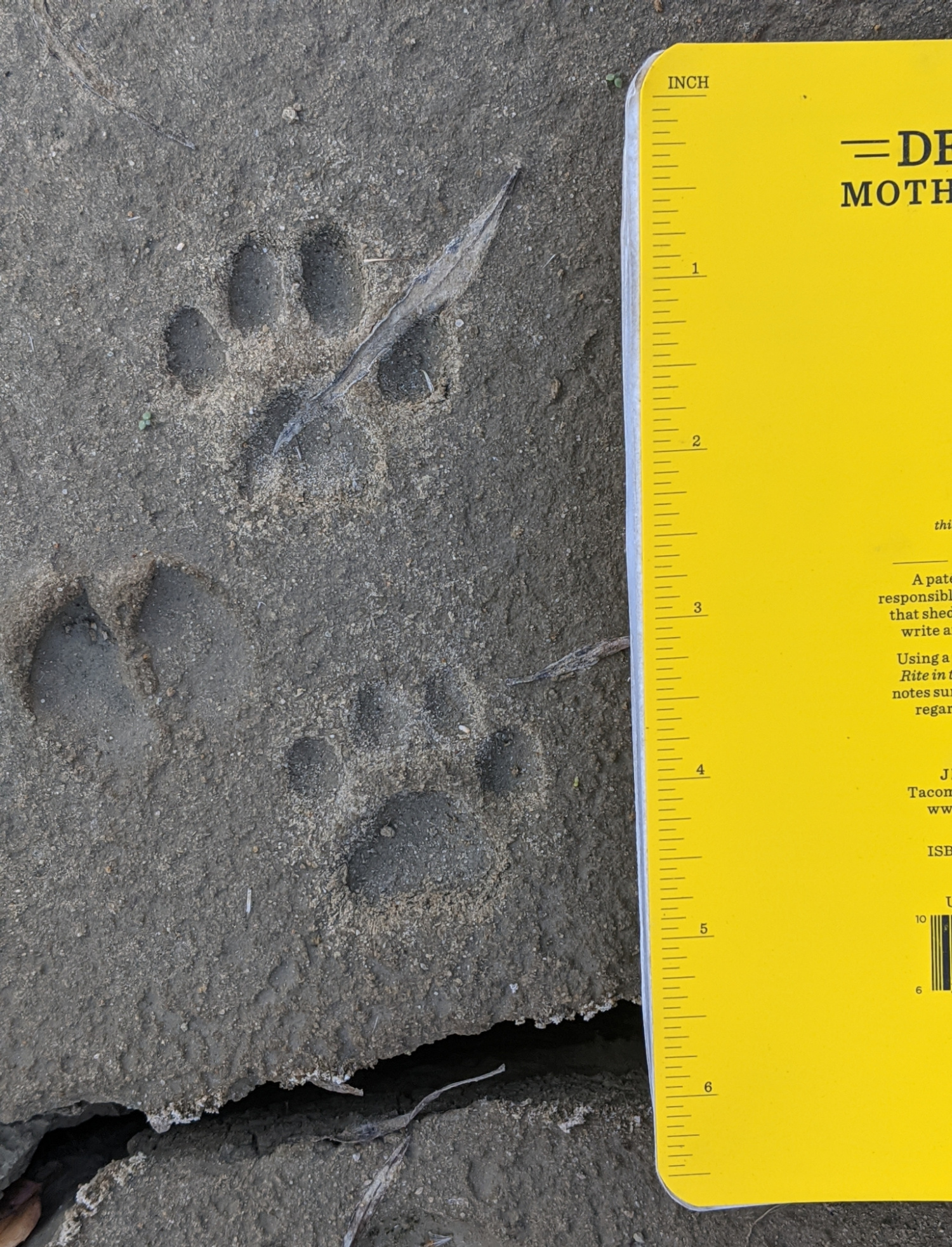
Photograph by Zack Abbey
Bobcat tracks have a classic feline look, with three-lobed heel pads and four toes without distinguishable claws. They’re smaller than mountain lion and lynx tracks, but larger than common house cat tracks.
Bobcat track dimensions: 1 ¾ inches long, 1 ⅞ inches wide
Mountain Lion Tracks
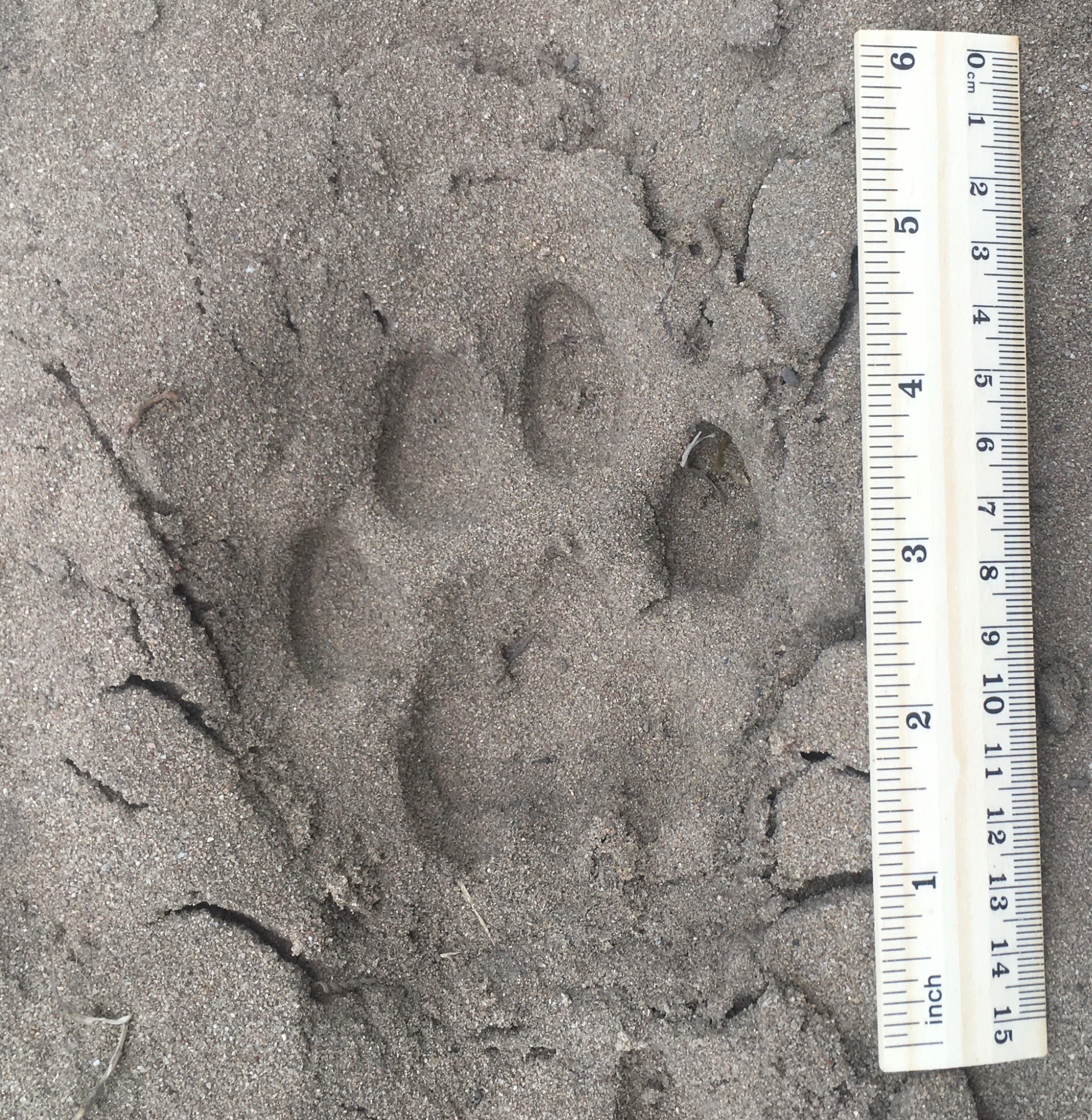
Photograph by Henrik Kibak
Mountain lion tracks are large and crisp. Unlike lynx, mountain lions don’t have long fur around their paws, so the tracks will be quite distinct. Look for uneven front toes — if it’s a right paw, the front left pad will poke out in front slightly, similar to a human middle finger (if you think of our thumbs as dewclaw, of course.)
Mountain lion track dimensions: 2 ⅕ to 4 ⅕ inches long, 1 ⅗ to 4 ⅓ inches wide
Lynx Tracks
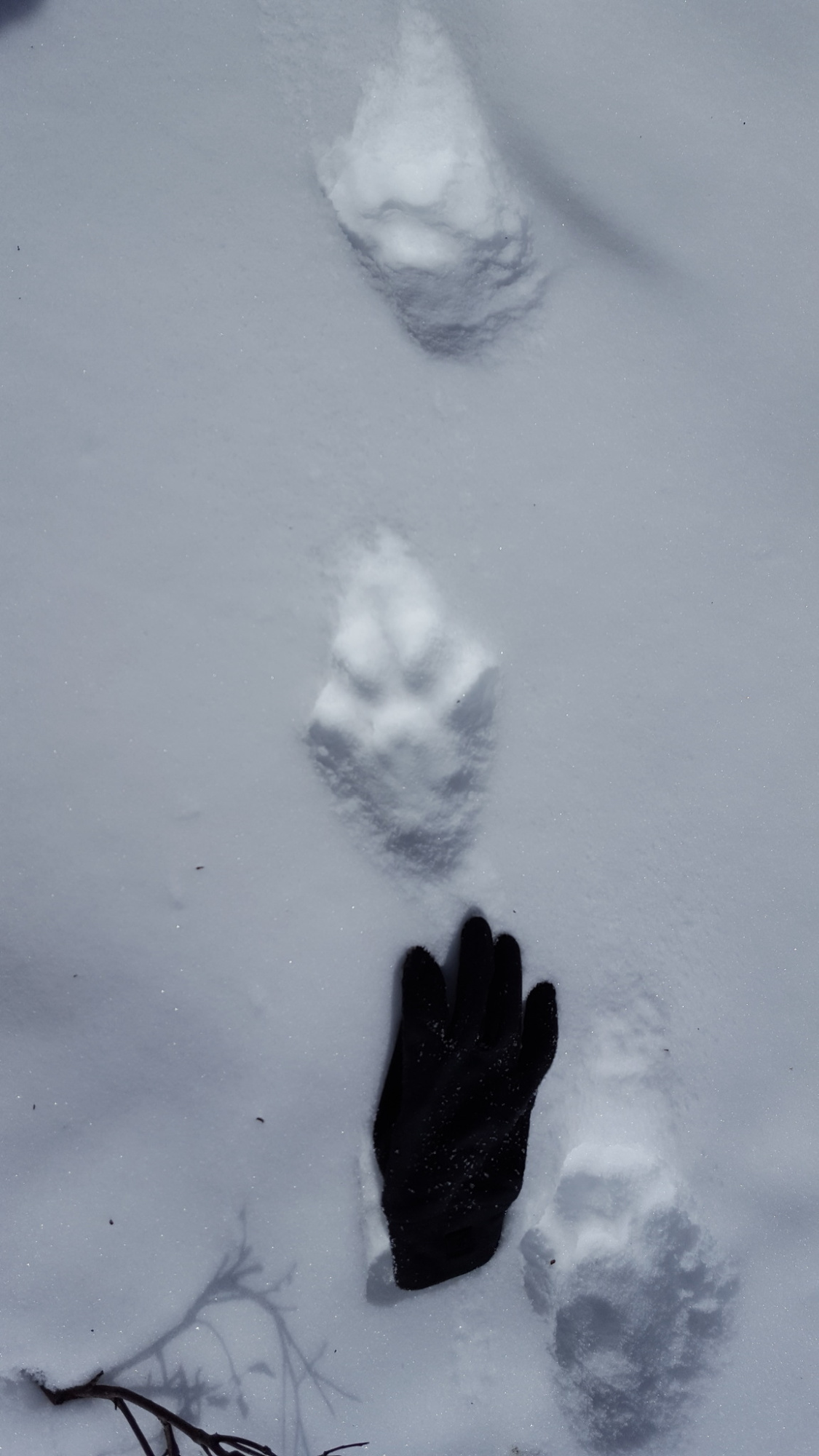
Photograph by Norma Malinowski
Lynx tracks are round, big, and sloppy on the edges. If you’re tracking in snow, look for drag marks left behind by the long fur on their paws.
Lynx track dimensions: 3 ¾ inches long, 3 ⅜ inches wide
Common House Cat Tracks
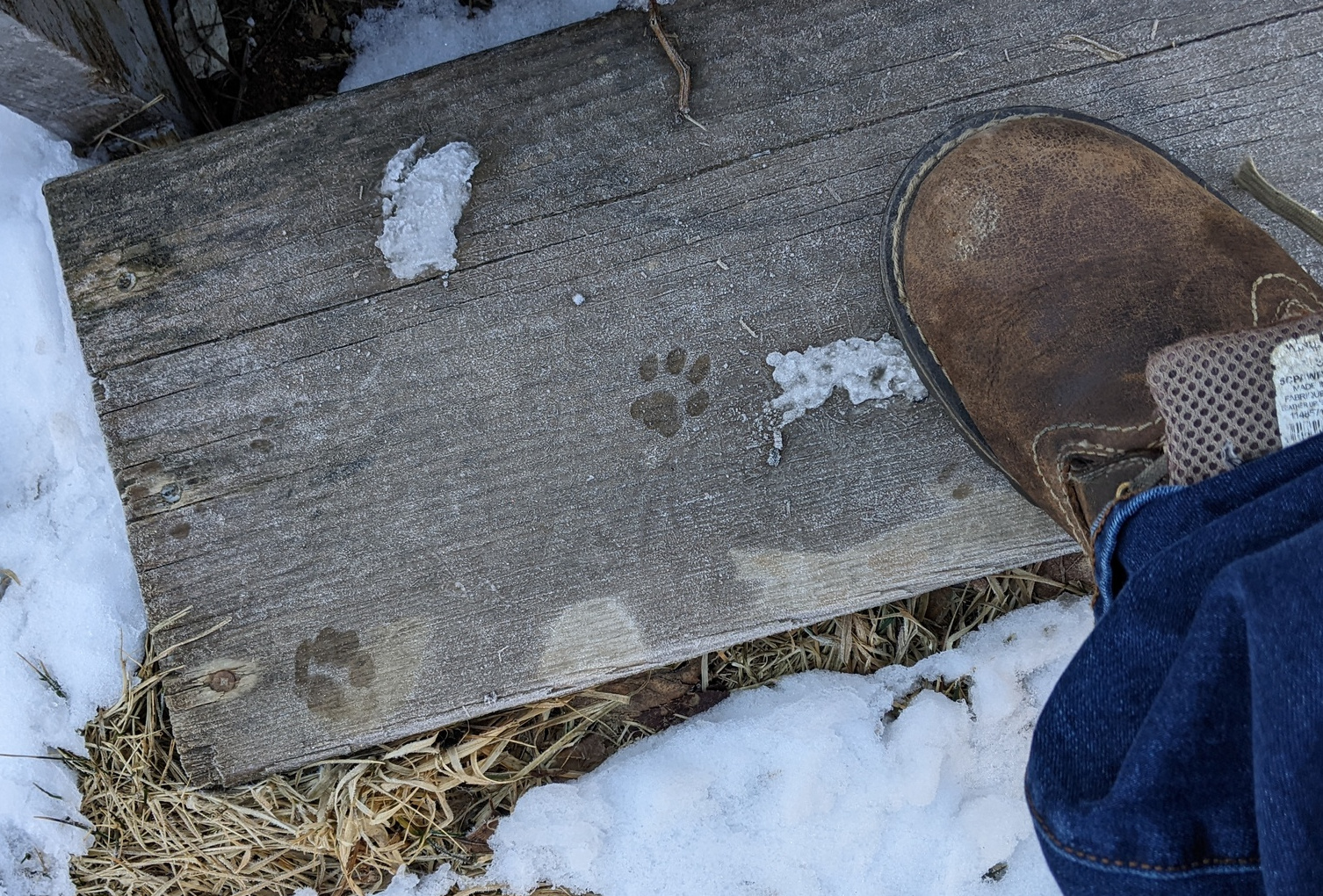
Photograph by Alicia Penney
Common house cat tracks will display as classic feline tracks with three-lobed heel pads, small or nonexistent claw marks, and a round overall shape. They’ll be smaller than bobcat tracks and might show some fur in and around the track, depending on what species left them behind.
Common house cat track dimensions: 1 ½ inches long, 1 ⅜ inches wide
Animal Tracks: Game Birds
Tracking game birds in harder substrate can be tricky since their light bodies don’t leave huge impressions in the ground. But bigger-bodied birds like turkeys leave more of a trail, and if you’re hunting in snow, mud, or wet, sandy soil, it shouldn’t be too hard to pick up on some game bird tracks.
A fun tip for tracking game birds: Most species have extremely small or entirely absent rear-facing toes, unlike anisodactyl “classic” tracks that show a long backward-facing toe for perching on branches. (This toe is called a “hallux.”) If you see a bird track on the ground with an equally long hallux, it’s probably not the game bird you’re looking for.
Turkey Tracks
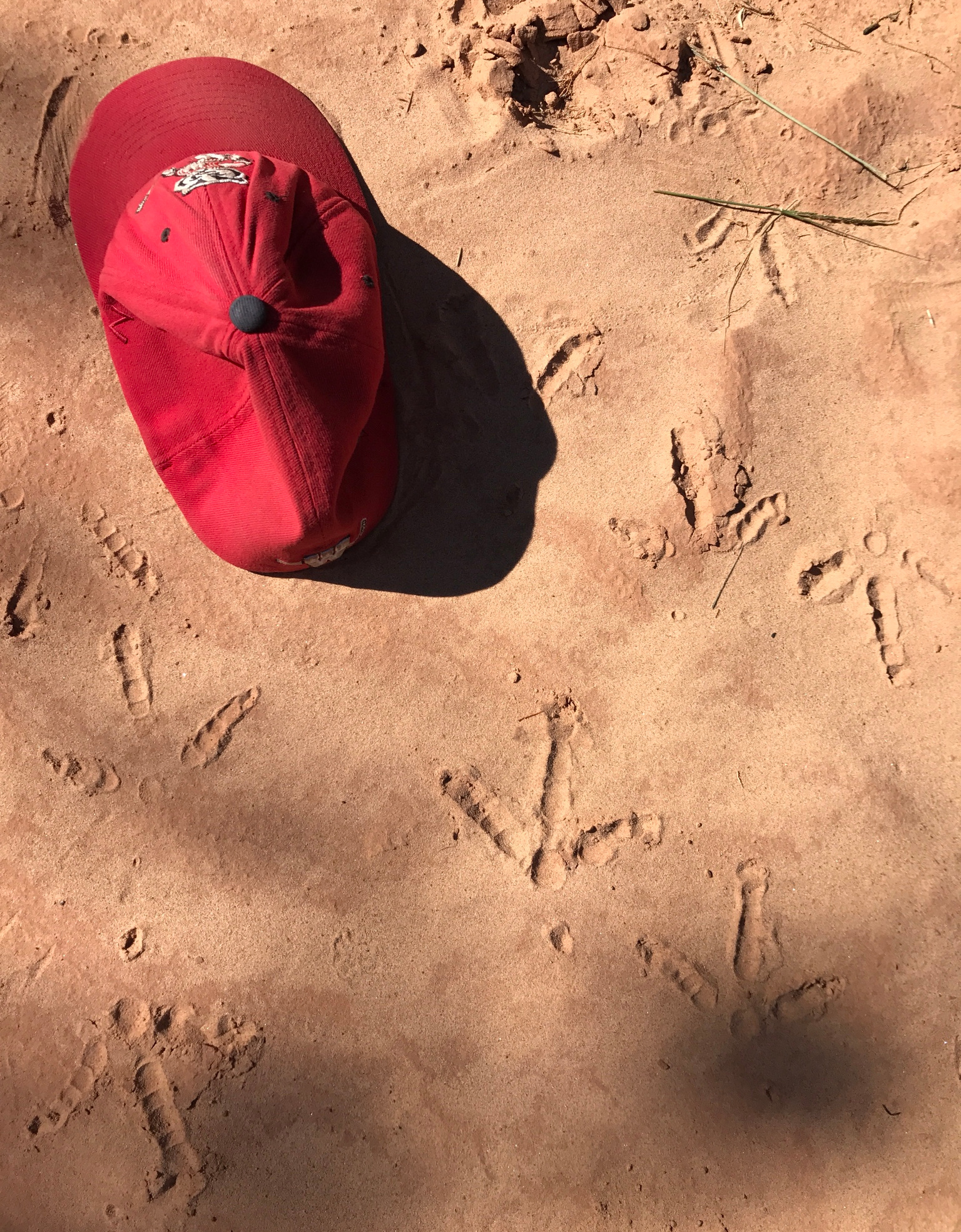
Photograph by Aaron Allen
Turkey tracks have three outward-facing toes with a small or nonexistent hallux. They’re some of the biggest game bird tracks you’ll see.
Turkey track dimensions: 3 ½ to 4 ½ inches long
Quail Tracks
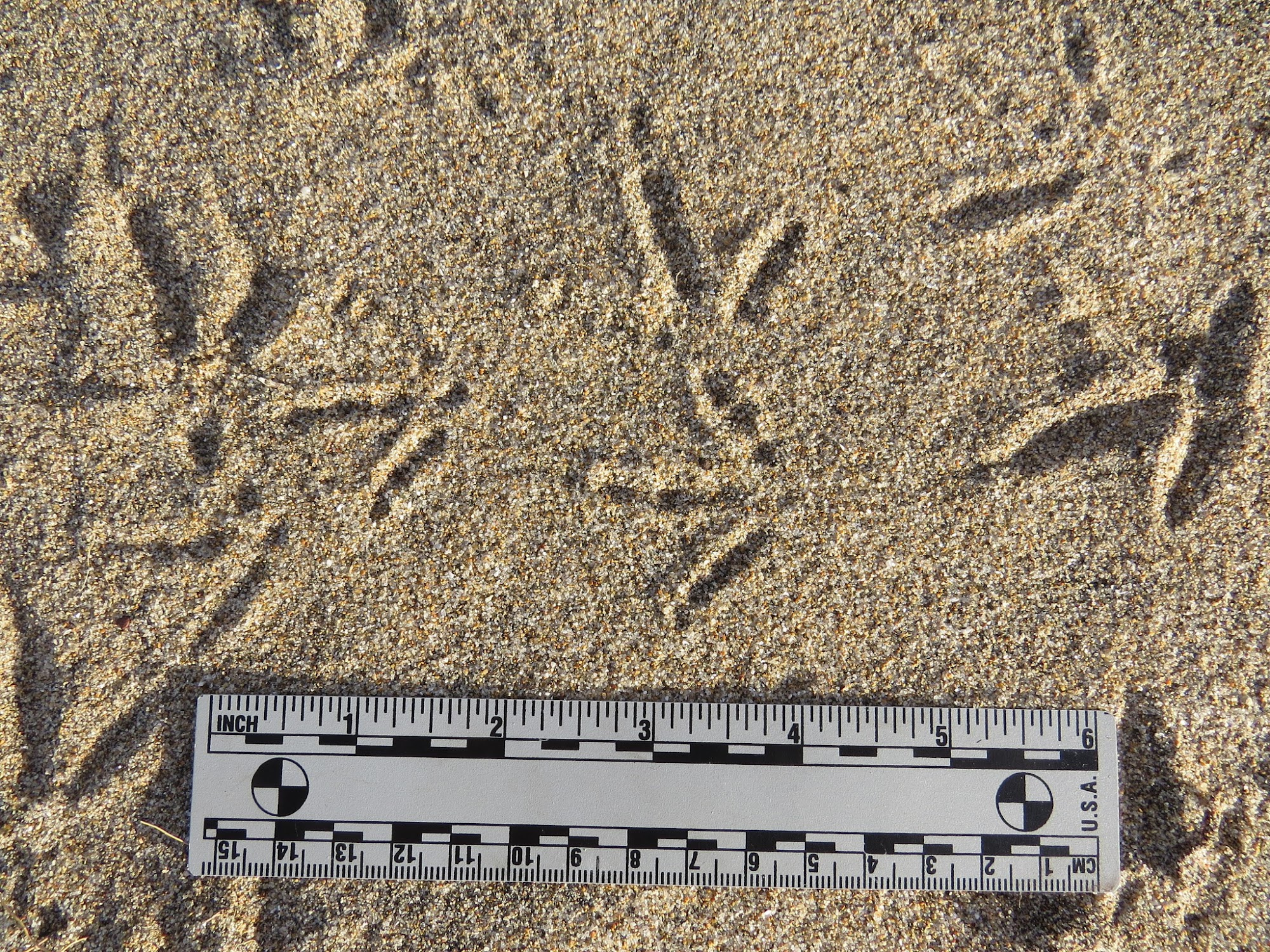
Photograph by Garth Harwood
Quail tracks are smaller than turkey tracks and have a very small hallux that shoots off to the interior side of the track.
Quail track dimensions: 1 ⅖ to 2 inches long
Grouse Tracks
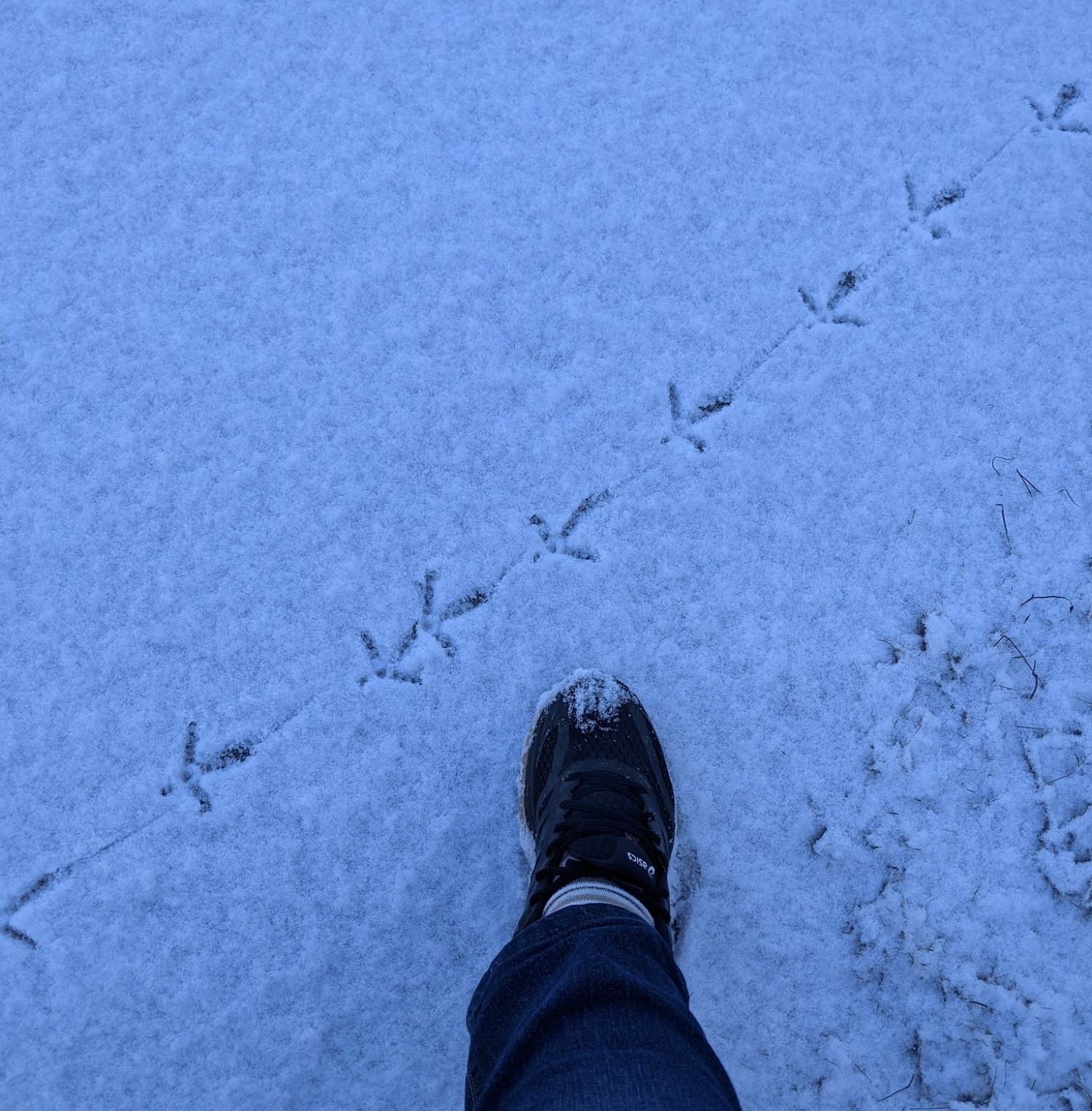
Photograph by Alicia Penney
Grouse tracks are extremely similar to quail tracks, except grouse are bigger and generally heavier than quail. Telling the two apart by their tracks alone is quite difficult.
Grouse track dimensions: 1 ⅖ to 2 inches long
Pheasant Tracks
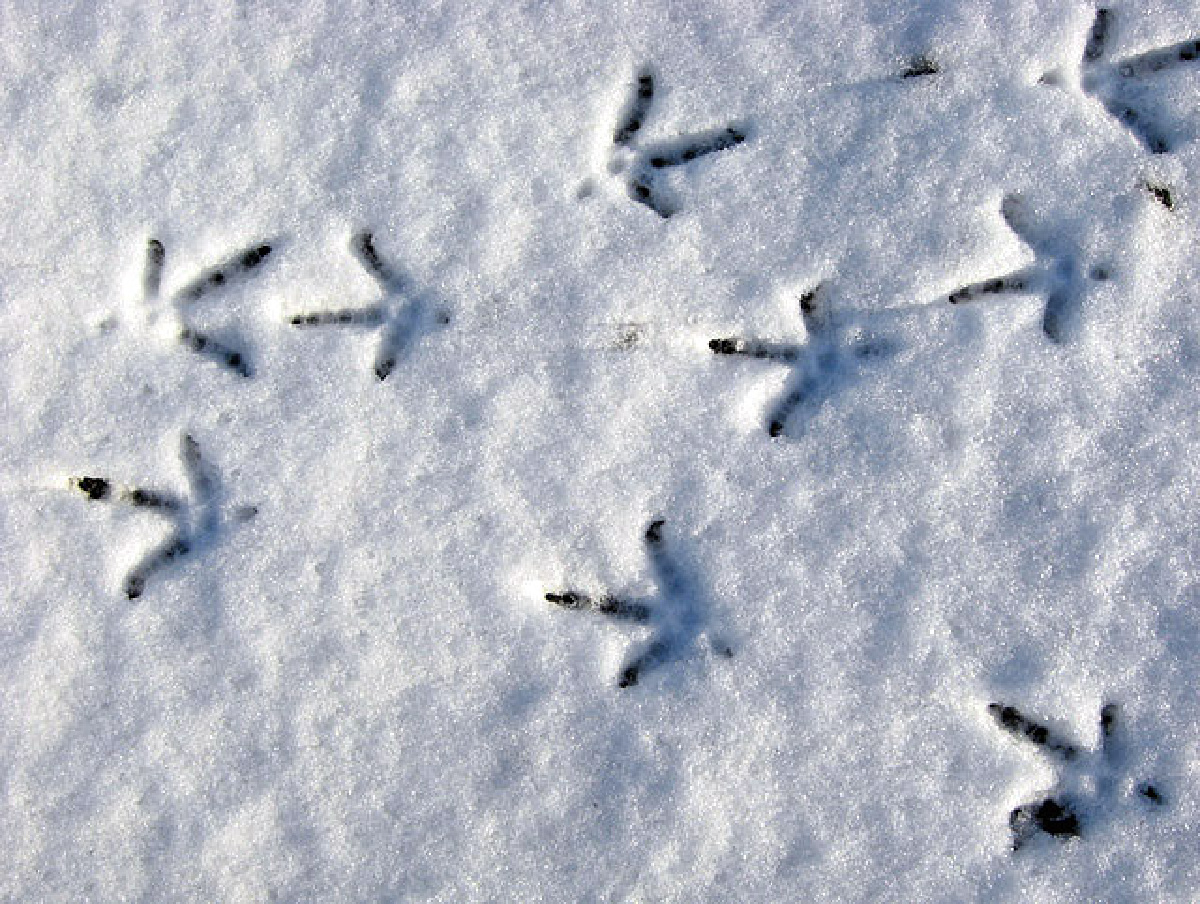
Photograph by Walter Baxter
Pheasant tracks also look quite similar to grouse and quail tracks, but slightly bigger. They’re not as big as turkey tracks, though.
Pheasant track dimensions: 2 to 3 inches long
Resources for Trackers
There is a groundswell of information out there for interested animal trackers of all ability levels, certified expert tracker and Texas Parks and Wildlife Department non-game wildlife biologist Jonah Evans tells Outdoor Life. His suggestions range from in-person courses to guidebooks and smartphone apps, like the one he created, iTrack Wildlife.
“Take one of our tracking certifications. In a weekend, you’re exposed to a huge breadth of information about wildlife tracks and sign, and that will leapfrog a person forward dramatically,” he says, referring to certification courses put on by CyberTracker North America. “Or, if you want to start learning on your own, start with the most common species in your area. Domestic dogs, house cats, deer, rabbits, species that are super common, start looking for those and pay attention to them. Start with easy species you’re going to see a lot … and field guides are fantastic. Mark Elbroch’s field guide is sort of the Bible of animal tracks.”
Cabrera agrees on the value of Elbroch’s field guide to any animal tracker in North America.
Gear for Tracking Animals
While the best tools for tracking animals consist of a sharp eye and identification knowledge, there are a few pieces of gear that can make tracking easier on beginners. (This is especially true if you have a dog in tow. Read up on the best dog GPS trackers in case you have a pup with a tendency to dart off chasing a scent.)
- Ruler
- Camera
- Item for scale (coin, dollar bill)
- Mirror
- Flashlight
- Magnifying glass
- Sketchbook and pencil
- Tape measure
- Tracking guide or smartphone app
Animal Track FAQs
When looking at animal tracks, you should at least have a ruler, camera, and something to scale the size of the track (like a quarter or a dollar bill). More advanced trackers will carry mirrors and flashlights to enhance the details of the track, or magnifying glasses to take a closer look. They might also sketch tracks in a sketchbook or bring a tape measure to determine the stride length. Some trackers like to make plaster casts of tracks out of Plaster of Paris.
Some trackers refer to the markings animals leave behind with their feet as “prints,” “sign,” or just “tracks.”
Carrying a ruler to measure animal tracks can be very helpful for identifying them. Measure animal tracks from the widest point side-to-side and longest point front-to-back to get an accurate set of dimensions.
Final Thoughts on Animal Tracks
Every animal that walks across a landscape leaves tracks behind. Knowing how to find and interpret those animal tracks is one of the best ways to see wildlife, whether you’re on a deer hunt or trying to round out your wildlife photography portfolio. So grab a small ruler, a camera, and maybe a guidebook, and go log some “dirt time.”

